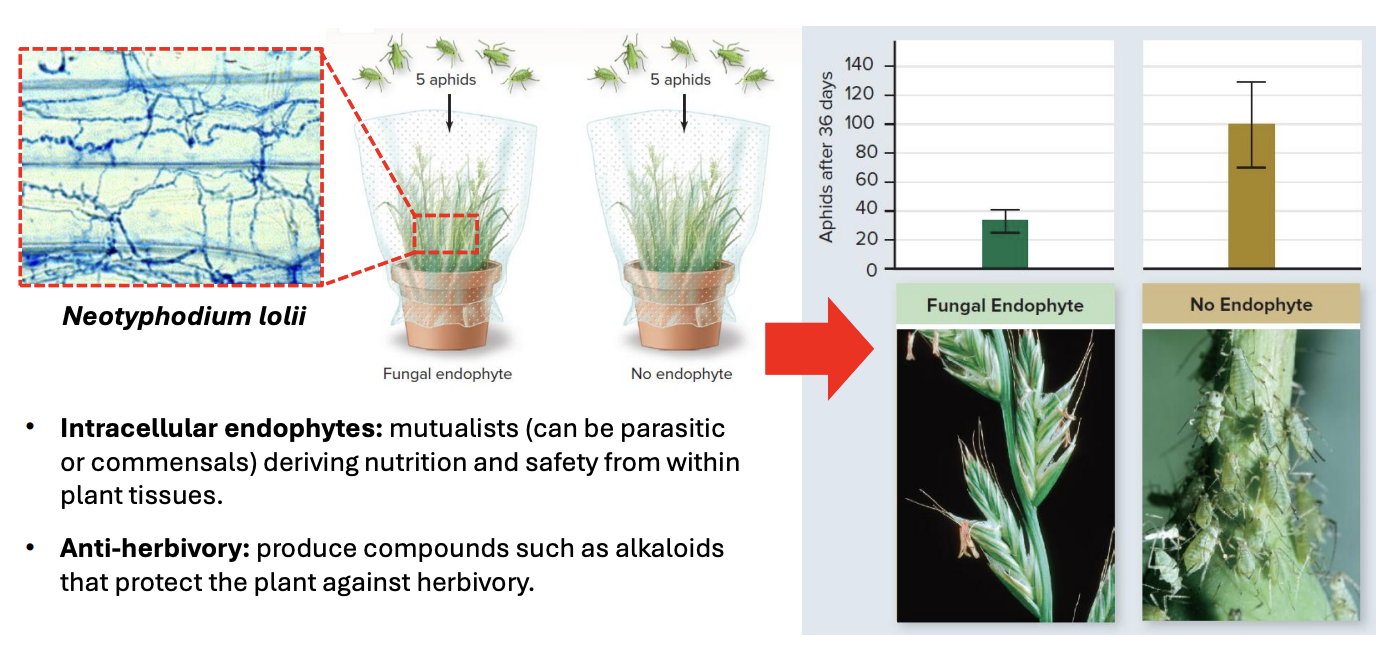MYCO 4.1A,B,C | Fungal Ecological Roles, Fungi-Fungi Interactions, Fungal Mutualisms pt. 1
1/138
There's no tags or description
Looks like no tags are added yet.
Name | Mastery | Learn | Test | Matching | Spaced |
|---|
No study sessions yet.
139 Terms
Fungi have critical roles in both terrestrial and aquatic environments, including _
bdnsi
Biotransformation, mineralization, & remediation
Decomposition of organic matter & carbon cycling
Nitrogen fixations & conversions
Symbioses (endophytes, lichens, AMF, etc.)
Interactions with terrestrial, aquatic, and marine flora & fauna
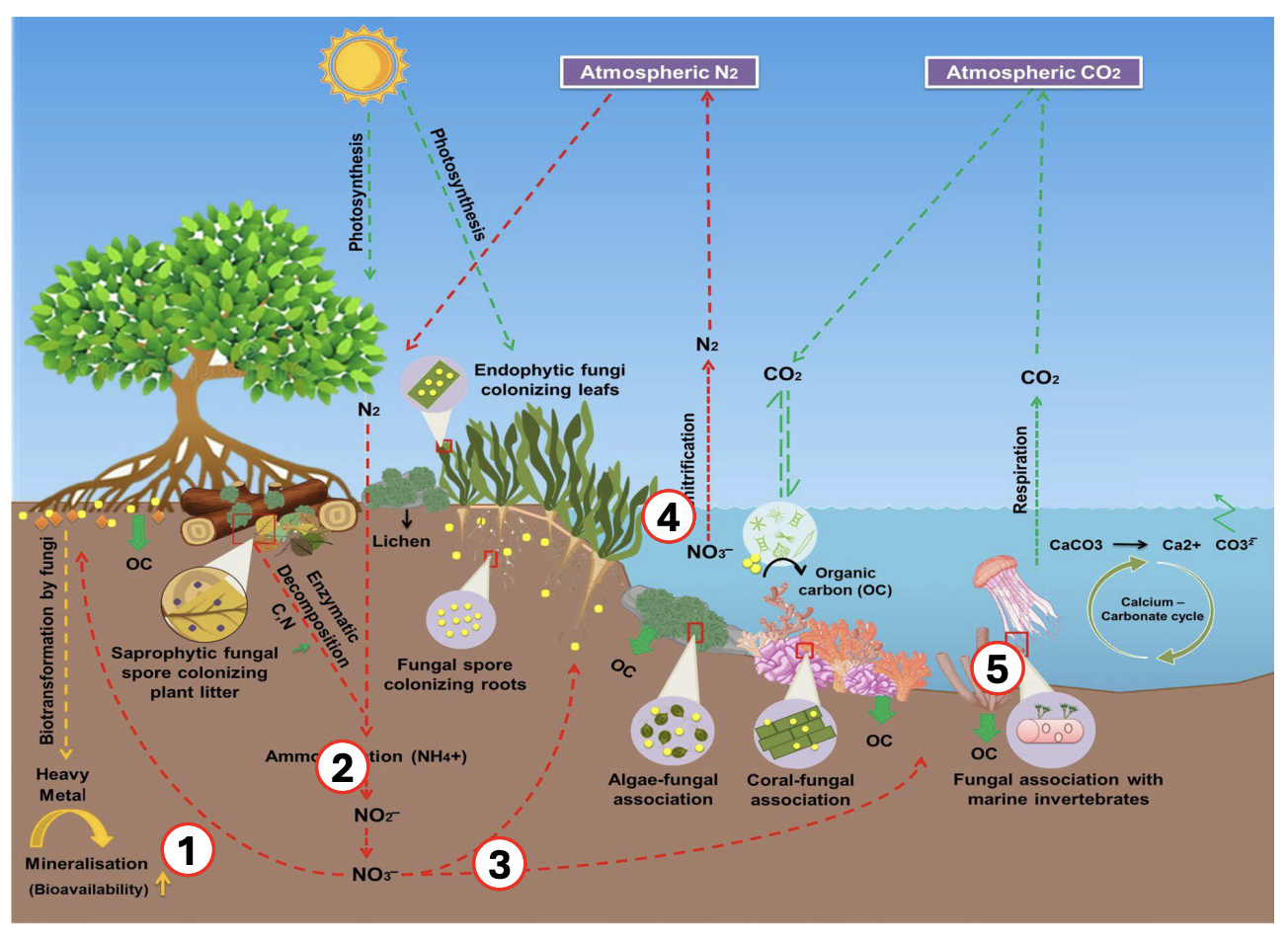
_ is the biochemical modification of 1 or more chemical compounds
Biotransformation

Biotransformation refers to the biochemical modification of 1 or more compounds, including reducing the environmental impact of metals, pharmaceuticals & personal care products, pesticides, and plastics, through 2 main processes:
Intracellular enzymatic processes
Cell-wall bound enzymes pqdt
Phenol monooxygenases
Quinone reductases
Dehalogenases
Transferases
Cytochrome P450 monooxygenases, nitroreductases
Extracellular enzymatic processes llmco
Laccases
Lignin peroxidases
Manganese peroxidases
Chloroperoxidases
Oxidoreductases
Transforming pollutants into products including mdo
metabolites (more/less harmful to environment)
degradation products (complex > simple),
organic molecules
phosphate > ATP (inorganic > organic) = assimilation
ATP > phosphate (organic > inorganic) = mineralization

Biotransformation produces products, including:
mdo
Metabolites (could be less or more harmful)
Degradation products (complex > simpler)
Organic molecules (organic > organic; inorganic > organic, e.g., phosphate > phosphorus, e.g., ATP via assimilation)
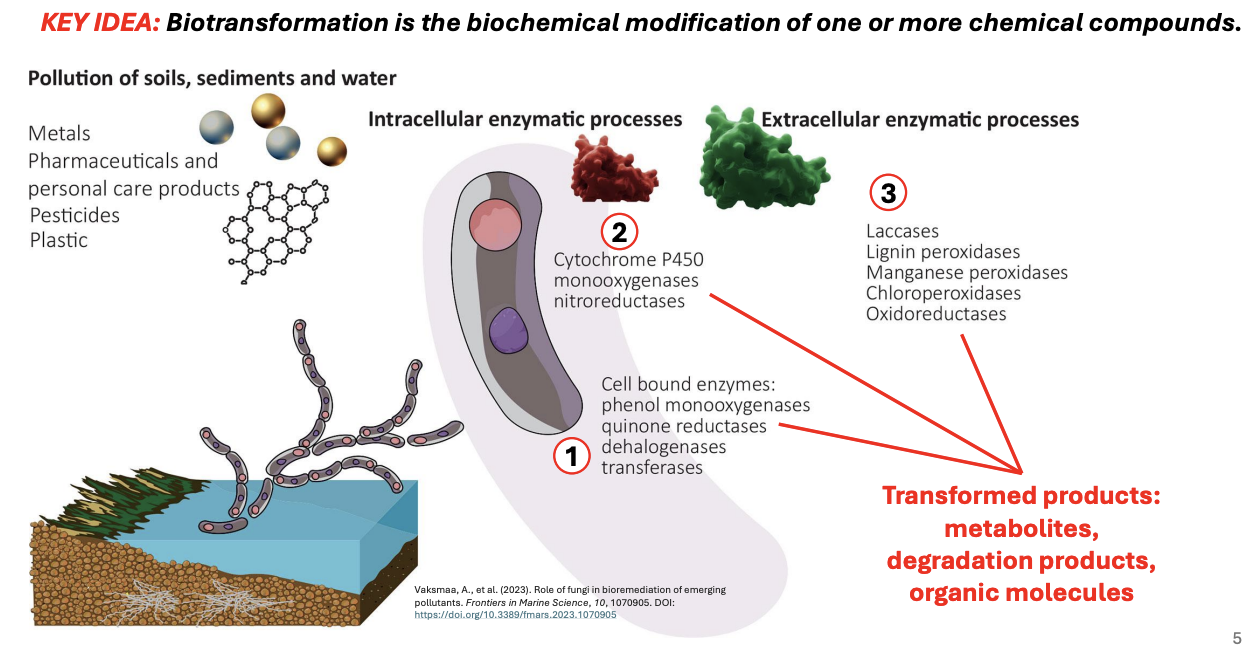
_ is the decomposition of chemical compounds in organic matter and their release in soluble inorganic forms that may be available to other organisms, e.g., phosphorus tends to bind to soil particles and complex with metals in the soil, making it unavailable to organisms even when it is present
Mineralization
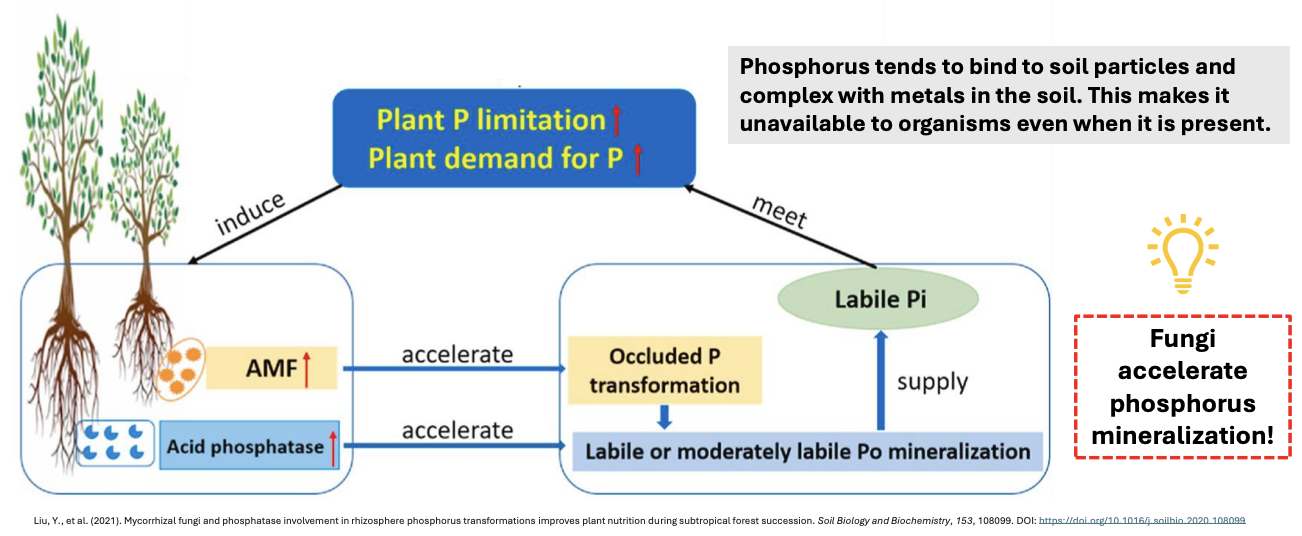
Explain how fungi (AMF) accelerates phosphorus mineralization
Increased plant P limitation and P demand induce their relationship with AMF, which enhances P uptake through 2 key mechanisms:
(1) extending their hyphae into the soil, thus increasing surface area for phosphorus absorption; and
(2) accelerating acid phosphatase enzyme production, which helps release phosphorus from organic matter
These processes facilitate the transformation of occluded P into labile or moderately labile Po mineralization, ultimately contributing to the labile Pi supply, and help meet plant P limitation & demand
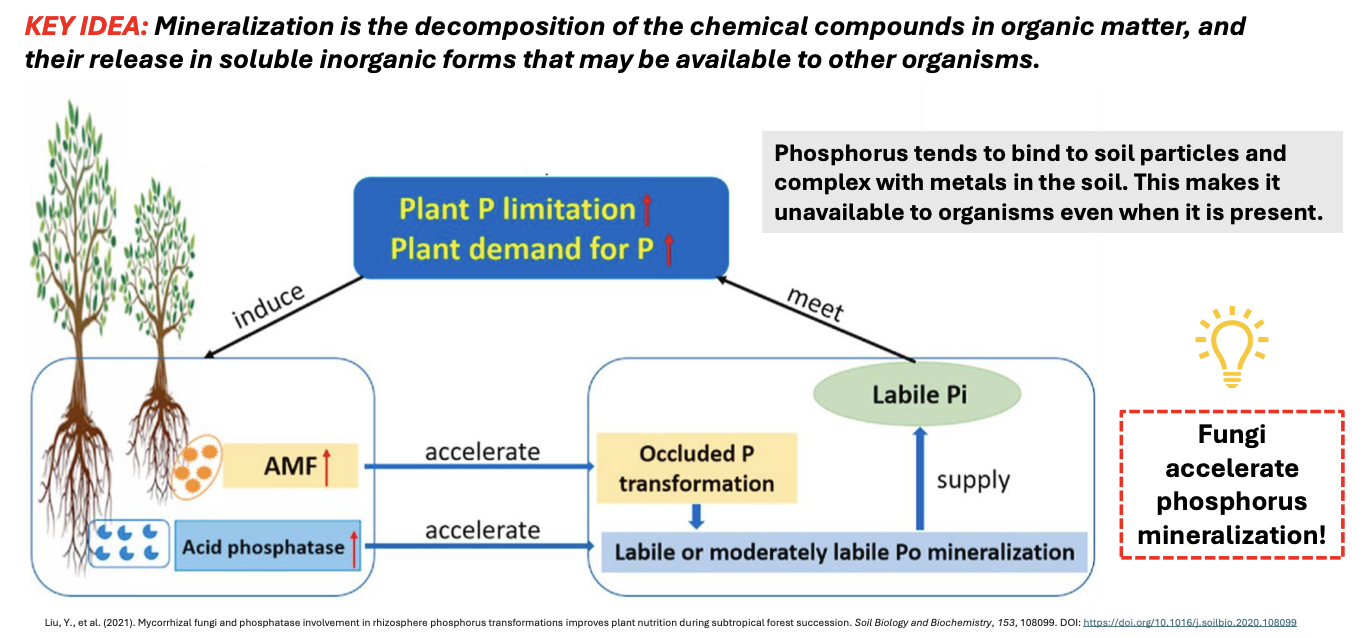
_ is the enzyme whose production is increased by AMF to help meet plant phosphorus demand & limitation, as these help release phosphorus from organic matter
acid phosphatase enzymes
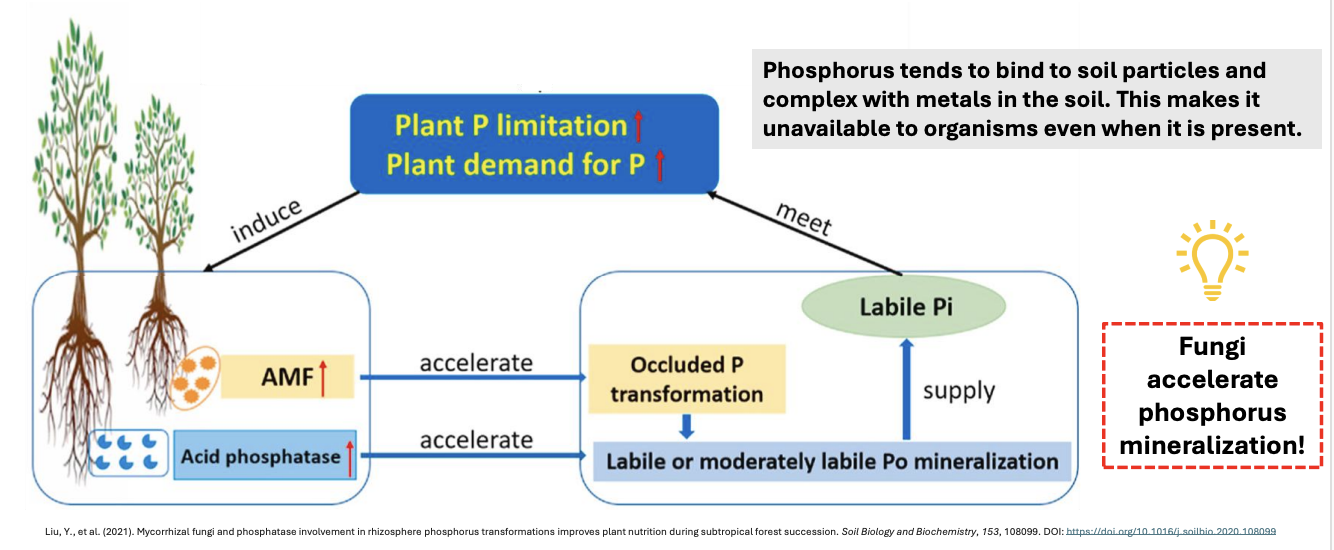
_ employs the use of living organisms, the removal, and/or the degradation of contaminants, pollutants, and toxins from soil, water, and other environments
Bioremediation
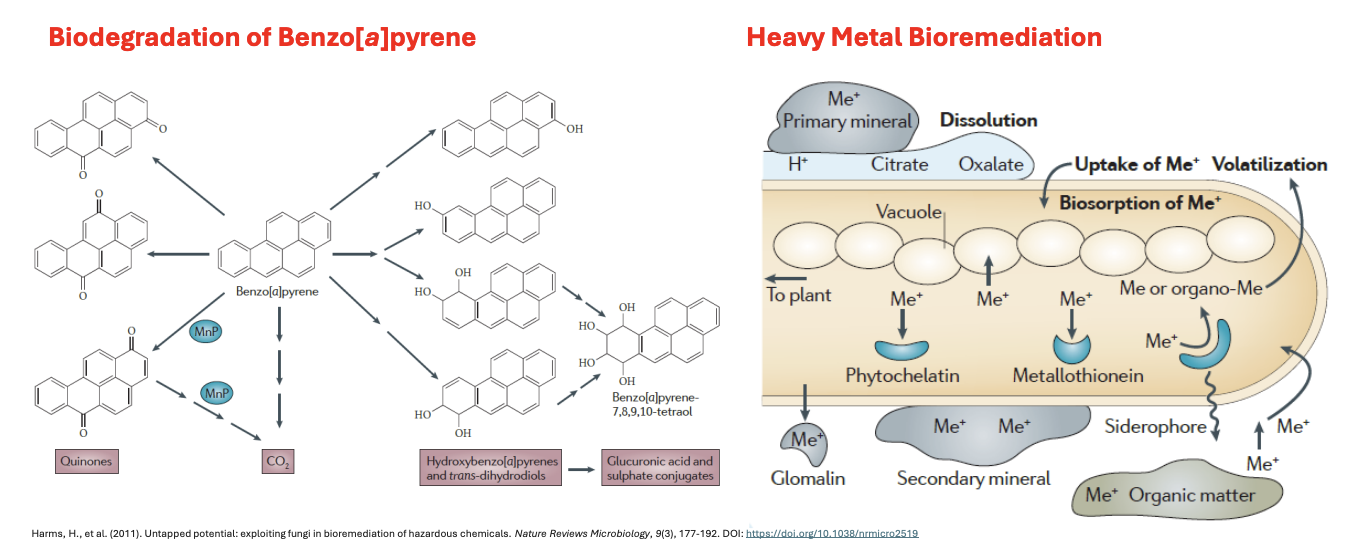
Explain 2 bioremediation processes fungi help facilitate
bbd hbr
Benzo[a]pyrene biodegradation
Benzo[a]pyrene = polycyclic aromatic hydrocarbon (PAH); known pollutant from pesticides, fertilizes
Fungi help oxidize benzo[a]pyrene into smaller, more degradable compounds via their manganese peroxidase (MnP) enzymes, transforming these into: qhg
Quinones,
Hydroxylated intermediates (hydroxybenzo[a]pyrenes, trans-dihydrodiols), and
Glucuronic acid & sulfate conjugates (all of which are more water-soluble + can be further metabolized)
with CO2 as the final breakdown product, indicative of complete mineralization of benzo[a]pyrene
Heavy metal bioremediation
Fungi also contribute to heavy metal bioremediation via various mechanisms including: dbs gsv
Dissolution of primary minerals by secreting organic acids, e.g., citrate and oxalate, into the environment, thus triggering the release of heavy metals
Biosorption of Me+ using biomolecules, e.g., phytochelatins & metallothioneins, that store or detoxify Me+ within plant cells
Secondary mineral transformation, where fungi precipitate Me+ as secondary minerals
Use of glomalin (AMF glycoprotein) as Me+ sink
Siderophores chelating metals, making these more bioavailable or less toxic
Volatilization & uptake, where metals are absorbed by fungi, stored in vacuoles, or volatilized as gaseous compounds
![<p><strong><em><u>bbd hbr</u></em></strong></p><ul><li><p><strong>Benzo[a]pyrene biodegradation</strong></p><ul><li><p><em>Benzo[a]pyrene = polycyclic aromatic hydrocarbon (PAH); known pollutant from pesticides, fertilizes</em></p></li><li><p>Fungi help <u>oxidize</u> benzo[a]pyrene into smaller, more degradable compounds via their<strong> manganese peroxidase (MnP) </strong>enzymes, transforming these into: <strong><em><u>qhg</u></em></strong></p><ul><li><p>Quinones,</p></li><li><p>Hydroxylated intermediates (hydroxybenzo[a]pyrenes, <em>trans</em>-dihydrodiols), and</p></li><li><p>Glucuronic acid & sulfate conjugates <em>(all of which are more water-soluble + can be further metabolized)</em></p></li></ul></li><li><p>with<strong> CO2 </strong>as the final breakdown product, indicative of complete mineralization of benzo[a]pyrene</p></li></ul></li><li><p><strong>Heavy metal bioremediation</strong></p><ul><li><p>Fungi also contribute to heavy metal bioremediation via various mechanisms including: <strong><em><u>dbs gsv</u></em></strong></p><ul><li><p><strong>Dissolution of primary minerals</strong> by <u>secreting organic acids</u>, e.g., citrate and oxalate, into the environment, thus triggering the release of heavy metals</p></li><li><p><strong>Biosorption of Me+</strong> using biomolecules, e.g., <strong>phytochelatins & metallothioneins</strong>, that store or detoxify Me+ within plant cells</p></li><li><p><strong>Secondary mineral transformation</strong>, where fungi precipitate Me+ as secondary minerals</p></li><li><p>Use of<strong> glomalin </strong>(AMF glycoprotein)<strong> </strong>as Me+ sink</p></li><li><p><strong>Siderophores</strong> chelating metals, making these more bioavailable or less toxic</p></li><li><p><strong>Volatilization & uptake</strong>, where metals are absorbed by fungi, stored in vacuoles, or volatilized as gaseous compounds</p></li></ul></li></ul></li></ul><p></p>](https://knowt-user-attachments.s3.amazonaws.com/9fb8708c-326d-4a79-a119-a7a464dc2b0e.png)
T/F: As long as fungi make something less toxic or polluted, it can already be considered a bioremediation mechanism
TRUE
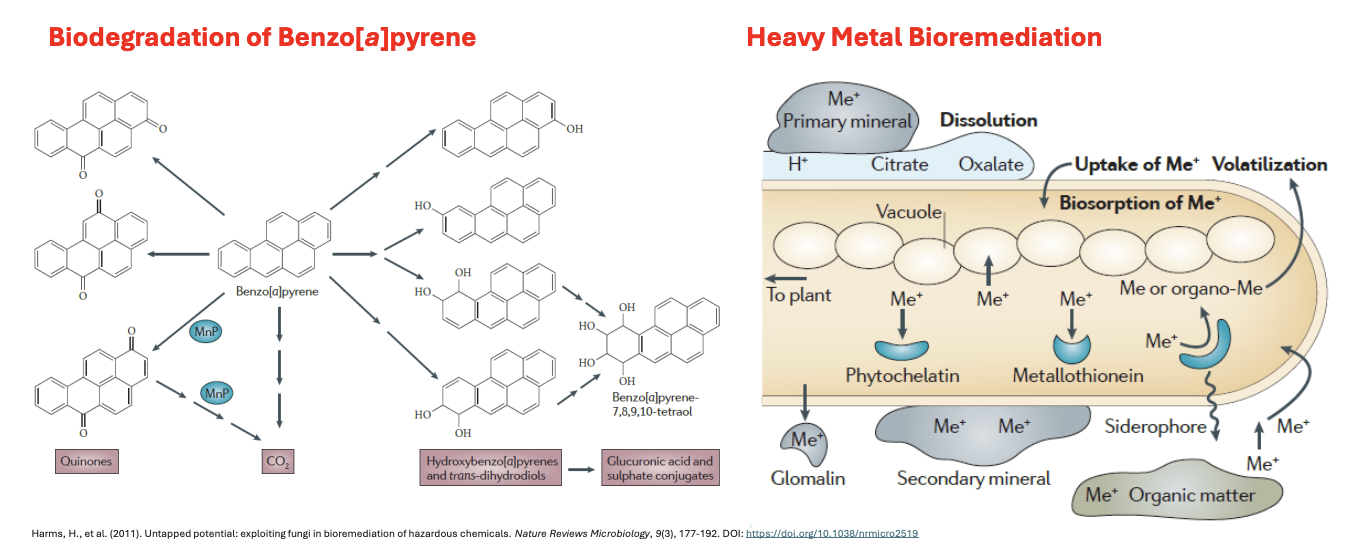
T/F: In biotransformation, the end products are always non-toxic metabolites that are harmless to the environment
FALSE
The end products of biotransformation are not always non-toxic. Sometimes, they can be more toxic than the original compound or may require further degradation
T/F: Phosphorus mineralization by fungi in the soil results in the formation of organic phosphorus that plants can directly absorb
FALSE
Phosphorus mineralization by fungi results in the conversion of organic phosphorus into inorganic phosphate, which plants can absorb
Fungi as _ degrade organic matter and release carbon
saprotrophs
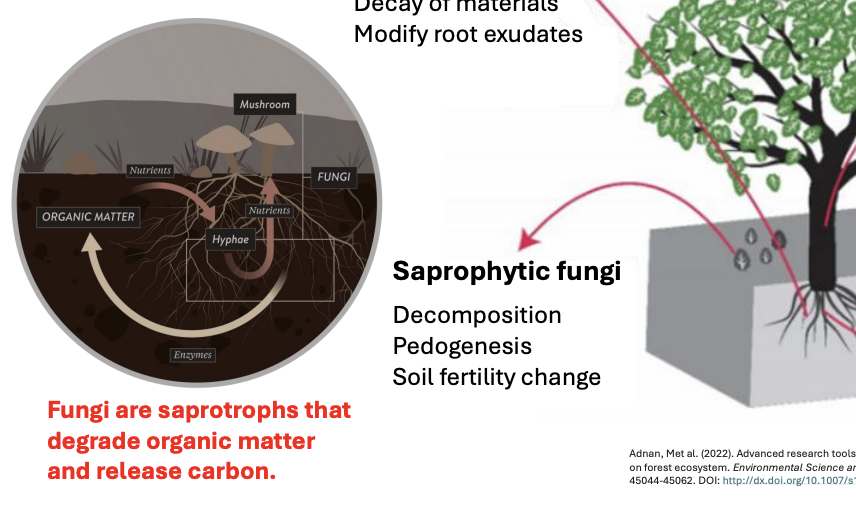
Fungi help in the cycling of nutrients and organic matter and the release of carbon as _
pems
Pathogenic fungi dm
Decay of plant materials
Modifying root exudates
Endophytic fungi nnc
Nutrient uptake
Nutrient exchange
Carbon sequestration
Mycorrhizal fungi nnle
Nutrient uptake
Nutrient exchange
Diminish nutrient leaching
Reduce erosion
Saprophytic fungi dps
Decomposition
Pedogenesis (study of soil origin & formation)
Soil fertility change
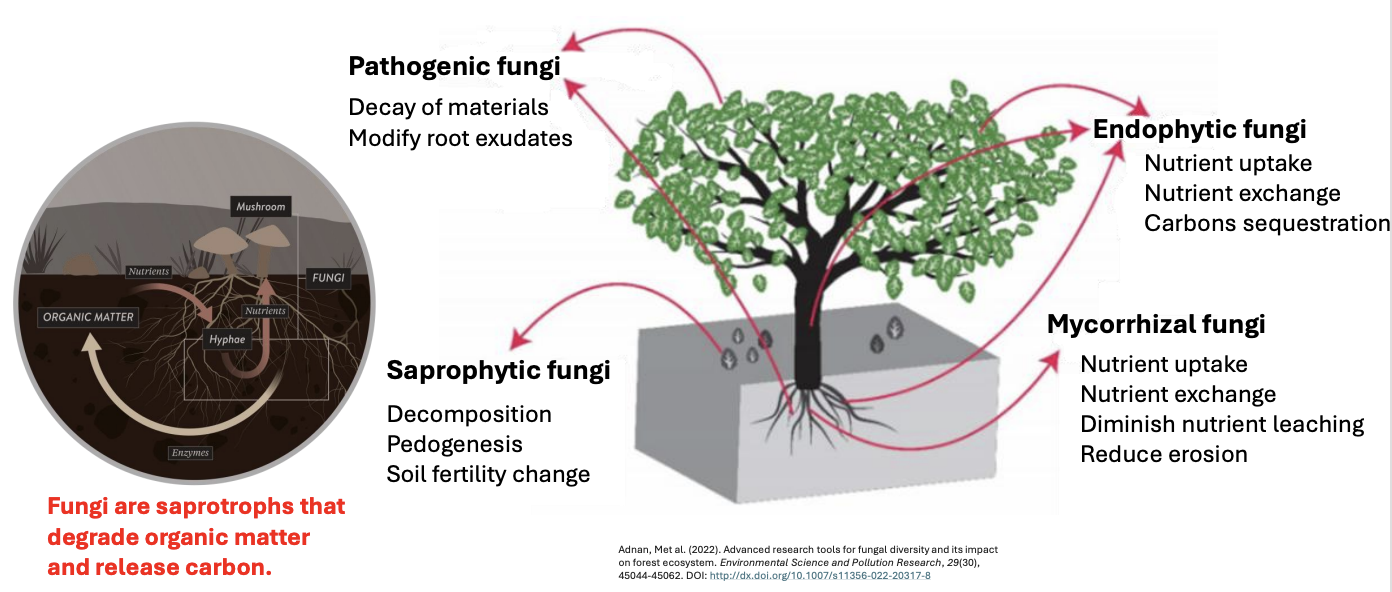
Decomposition is carried out in a series of steps dependent on _
flux of fungal inhabitants in an ecosystem

T/F: Fungi can help release inorganic matter from the environment via bioremediation, while they help release organic matter (and cycle carbon) from the environment via saprotrophic action
FALSE
Fungi can help release inorganic matter from the environment via biomineralization, while they help release organic matter (and cycle carbon) from the environment via saprotrophic action

The most important role of fungus is as _ since these aid in the decomposition & decay process of living things, meaning organic materials, such as carbon & sometimes nitrogen, trapped in dead organic matter will not be available to other organisms in the environment unless fungal depolymerase break these down and allow their release
saprotrophs (saprophytes)
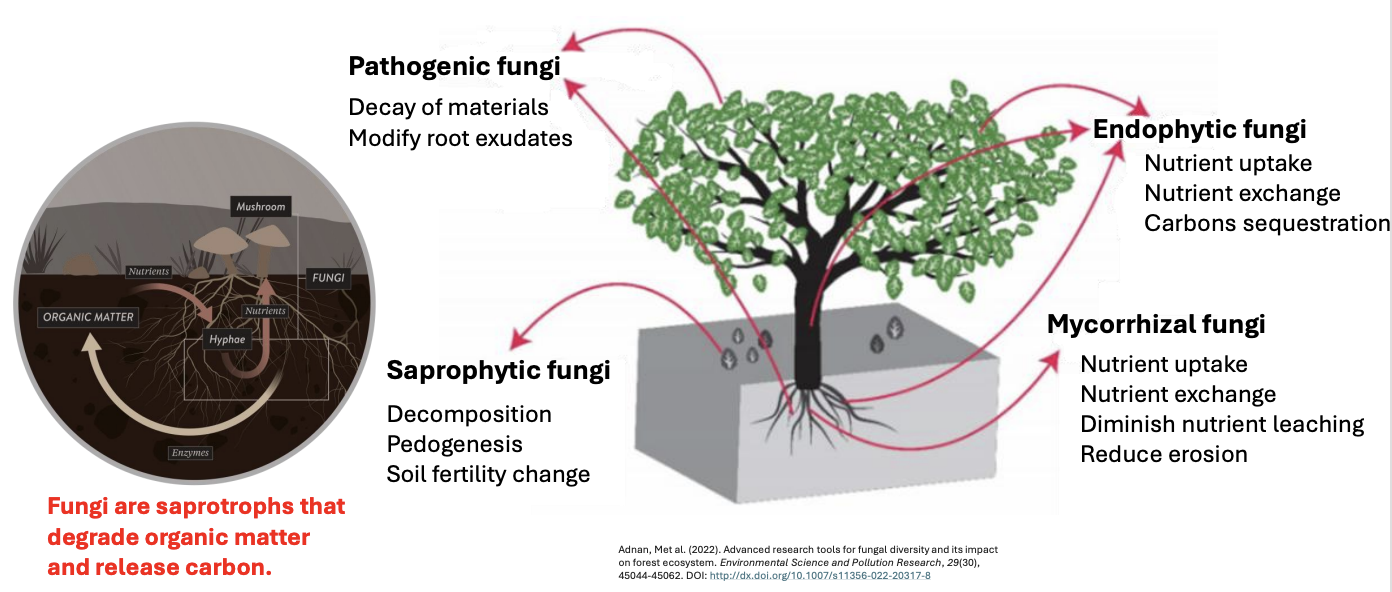
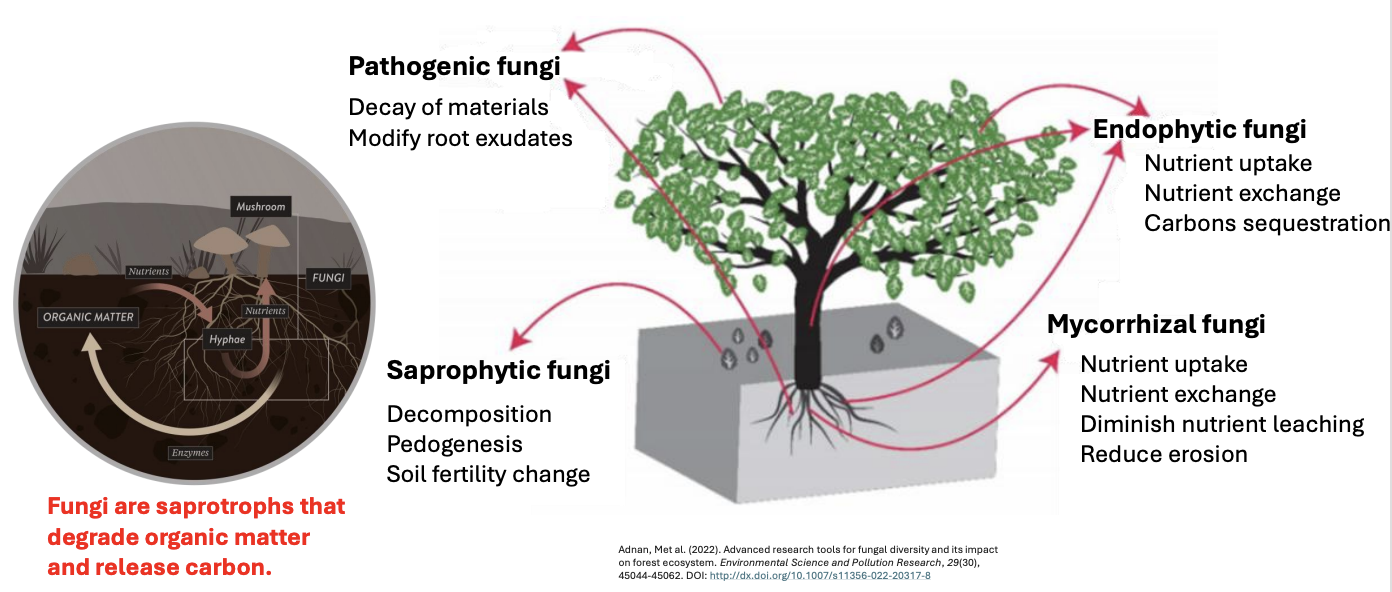
Explain why fungi as saprotrophs is one of their most important roles in ecosystem
This is because saprotrophic fungi aid in the decomposition & decay process of living things, meaning organic materials, such as carbon & sometimes nitrogen, trapped in dead organic matter will not be available to other organisms in the environment unless fungal depolymerases break them down and allow their release
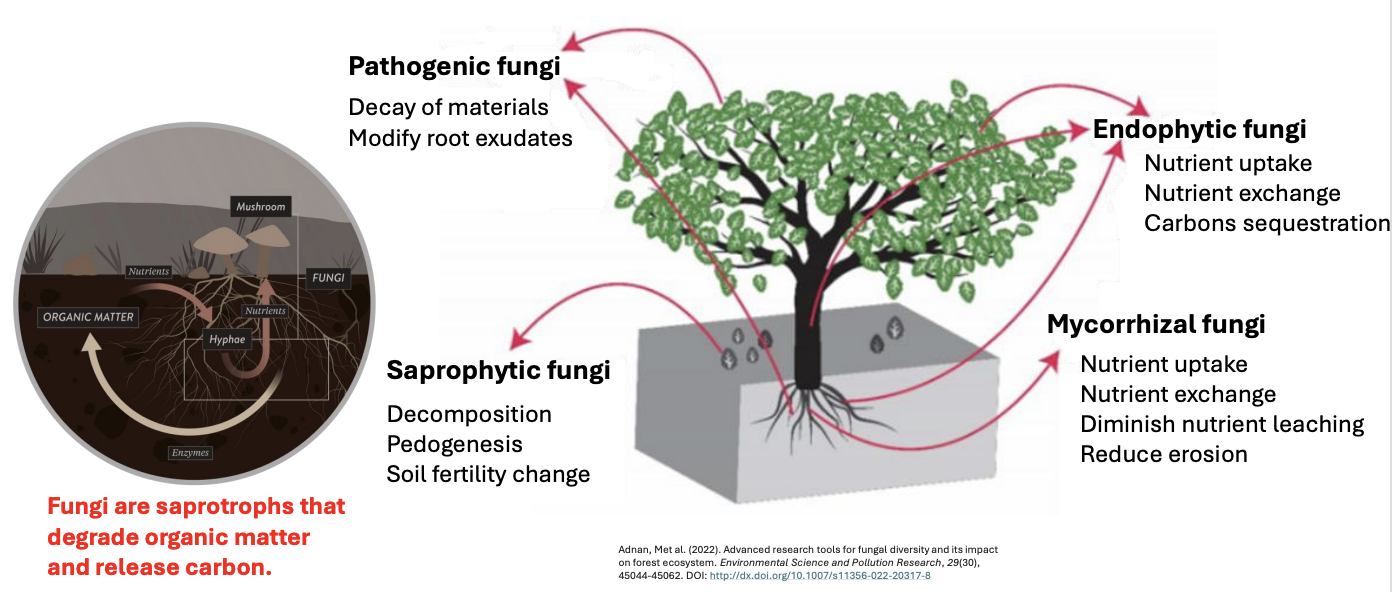
T/F: Carbon is one of the most mobile elements in the environment, thus it is necessary to interconvert this at a fast rate; limiting factor is usually the amount of carbon that can be taken from the dead organic material
TRUE
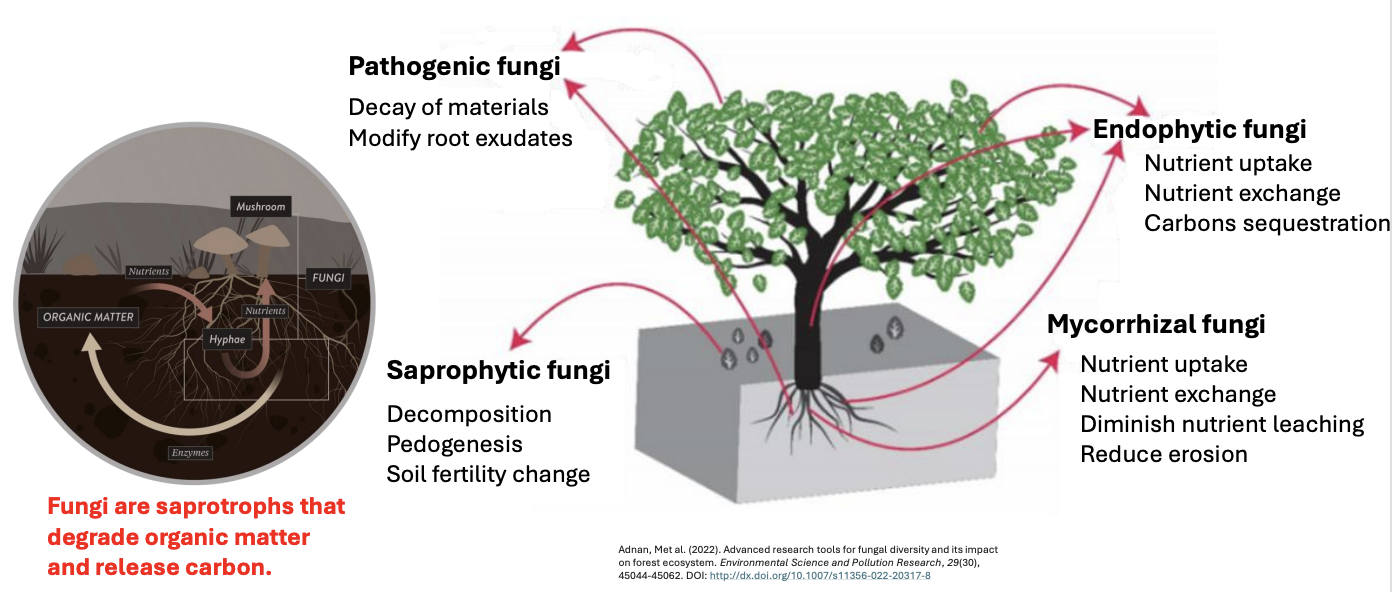
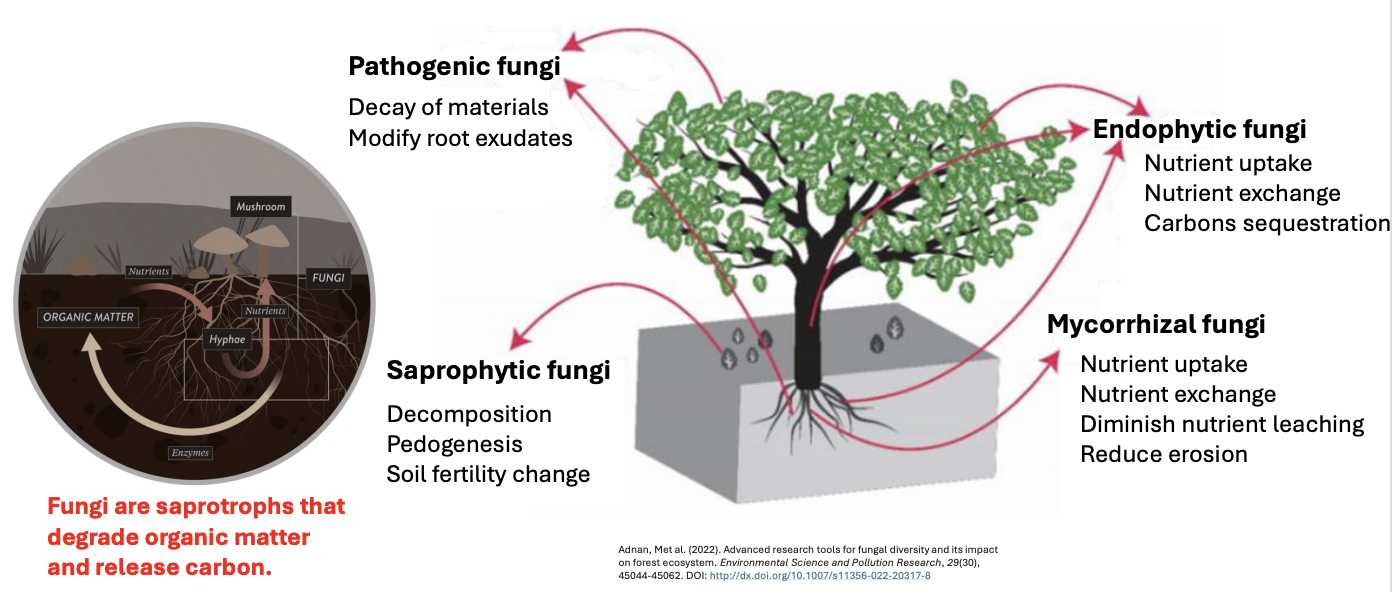
Carbon is one of the most mobile elements in the environment; the limiting factor is usually _
the amount of carbon that can be taken from the dead organic material (made available by depolymerases of saprotrophic fungi)
_ is the process of chemoheterotrophic (carbon & energy source = organic compounds) extracellular digestion involved in the processing of decayed (dead/waste) organic matter
Saprotrophy
_ is carried out in a series of steps dependent on flux of fungal inhabitants in an ecosystem
Decomposition

Explain fungi saprotrophic decomposition sequence
ewp psd
Epiphytic fungi: live on the host surfaces & start decomposition while the host is still alive
Weak parasites: infect weakened host but will not necessarily cause rapid death
Pioneer saprotrophic fungi: colonize dead organic matter after host death
Polymer-degrading fungi: as decomposition progresses, they break down complex macromolecules, e.g., cellulose, into simpler compounds
Secondary opportunistic fungi: take advantage of partially metabolized compounds & continue degradation
Degraders of recalcitrant compounds: dominate the final stage of decomposition, as these are capable of breaking down compounds highly resistant to degradation
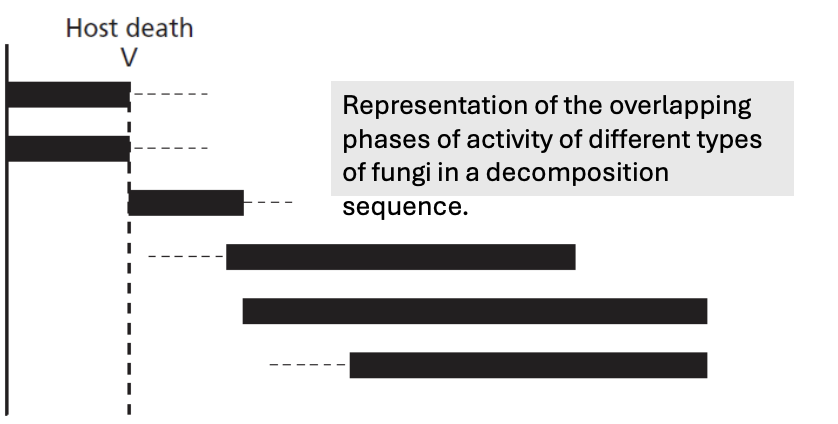
_ are chemical compounds highly resistant to degradation, whether via biological, physical, or chemical processes and thus persist in the environment for long periods because they are not easily broken down under natural conditions
Recalcitrant compounds

T/F: Degraders of recalcitrant compounds are the final and often longest-lasting fungal actors in decomposition
TRUE
They specialize in breaking down very resistant materials like lignin and melanin, and persist longer because of the difficulty of their task

T/F: Fungal decomposition contributes to atmospheric CO₂ increase by mineralizing organic carbon into CO₂ during saprotrophic activity
TRUE
Fungal respiration during saprotrophic breakdown releases CO₂ from organic matter — a major step in the carbon cycle. So yes, fungi are carbon cyclers and carbon releasers
Fungi play an essential role in nitrogen (N) cycling since they can _
Mineralize organic N (convert organic → inorganic)
Assimilate inorganic N to build their biomass
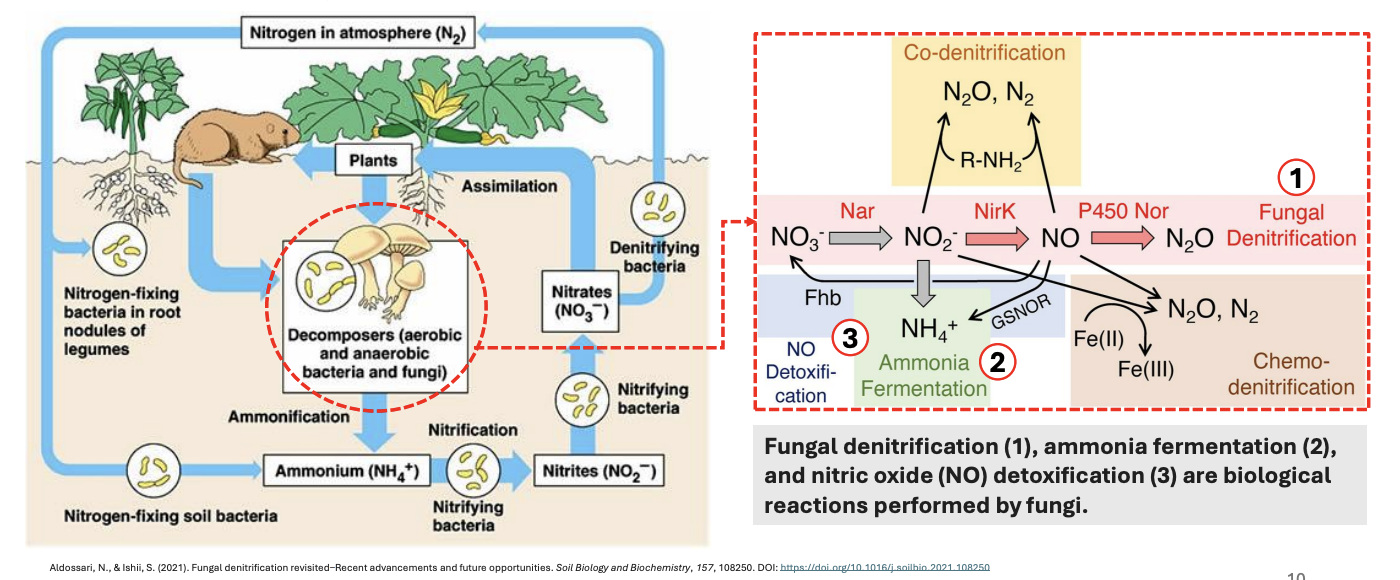
Explain role of fungi in nitrogen fixation & conversions
Nitrogen-fixing bacteria (in root nodules of legumes + soil) are mainly responsible for nitrogen fixation
Atmospheric N2 → NH4+
Decomposers (aerobic & anaerobic bacteria & fungi) break down organic N2 from dead organisms into NH4+ via ammonification
Organic N2 → NH4+
Nitrification (by nitrifying bacteria)
NH4+ → NO2- → NO3-
Assimilation is when plants absorb NO3- or NH4+ & convert these back to organic N2
NO3- or NH4+ → organic N2
Denitrification is when denitrifying bacteria/fungi return N to atmosphere
NO3- → NO2- → NO → N2O
3 primary roles of fungi in nitrogen conversion dan
Fungal denitrification
NO3- → NO2- → NO → N2O
Nar, NirK, P450 Nor
don’t usually reach N2
Ammonia fermentation
In low-O2 conditions, fungi can use ammonium as energy source
NH4+ → ATP + byproducts
Nitric oxide (NO) detoxification
Fungi have enzymes like Fhb & GSNOR that detoxify NO
NO → harmless compounds

Enumerate & explain the 3 roles of fungi in nitrogen conversion
*Order = principal activities their most involved in
Fungal denitrification
NO3- → (Nar) NO2- → (NirK) NO → (P450 Nor) N2O
Ammonia fermentation
Under low-O2 conditions, fungi can use NH4+ as energy source
NH4+ → ATP + byproducts
NO detoxification
Fungi have Fhb & GSNOR enzymes that can detoxify nitric oxide (NO)
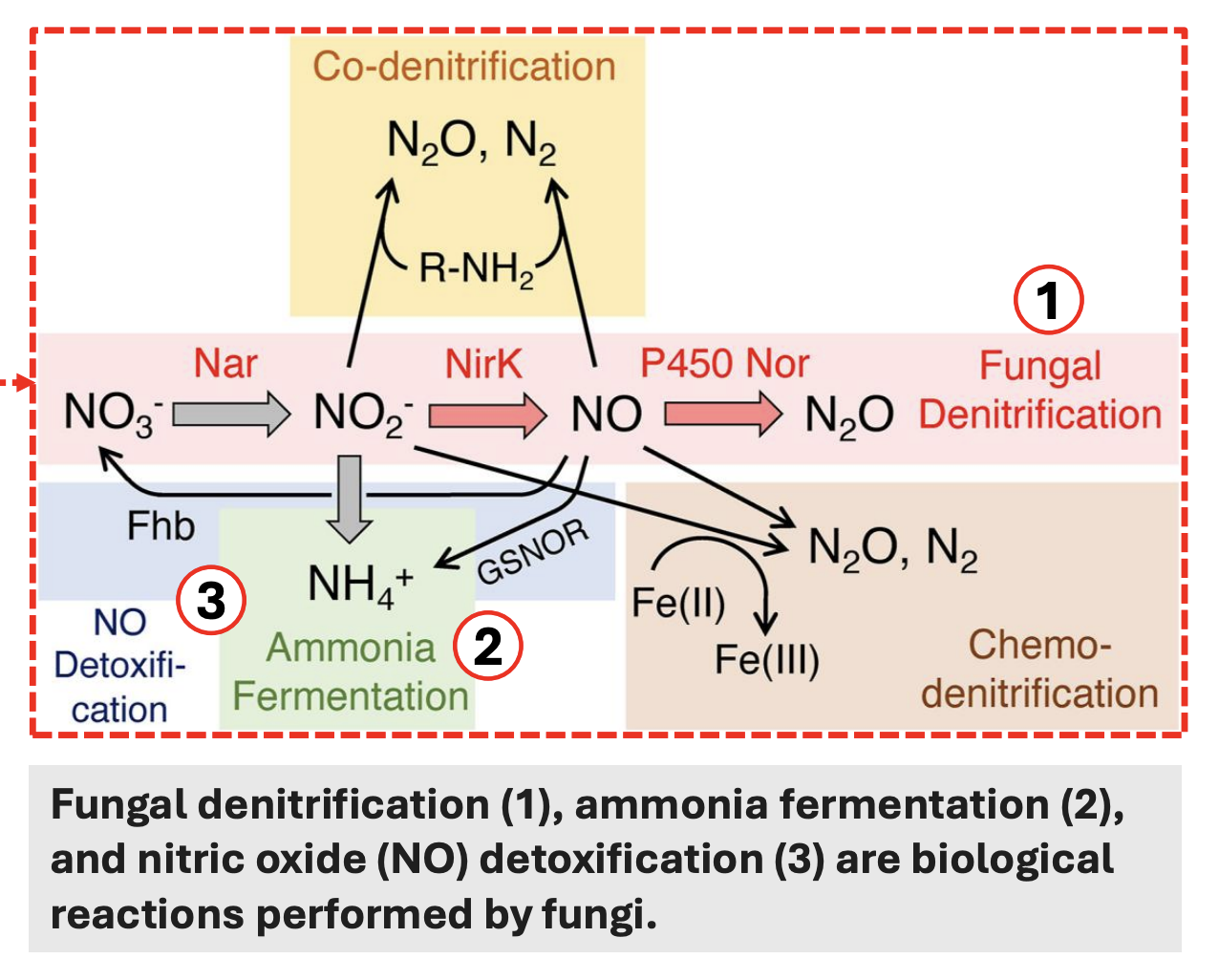
T/F: In fungal denitrification, nitric oxide (NO) is the final product excreted into the environment
FALSE
NO is intermediate; fungi can further reduce it to N₂O using P450 Nor
T/F: Fungi contribute to nitrification by converting ammonium (NH₄⁺) to nitrites (NO₂⁻)
FALSE
That’s the bacterial nitrifiers’ job, e.g., Nitrosomonas
Fungi don’t do nitrification NH4+ → NO2- → NO3-,
Only ammonification organic N2 → NH4+
denitrification NO3- → NO2- → NO → N2O
Fungi form several types of symbioses with other organisms in many kinds of habitats, including _
eml
Endophytes
Neotyphodium spp. are common endophytes within leaf tissues
Mycorrhizae
Mycorrhizae are associated with roots of > 90% of all plant species
Can turn parasitic quickly when certain conditions are not met
Lichens
Lichens are any of about 15,000 species of organisms that consist of symbiotic associations of algae (usually green) or cyanobacteria and fungi (mostly ascomycetes and basidiomycetes)
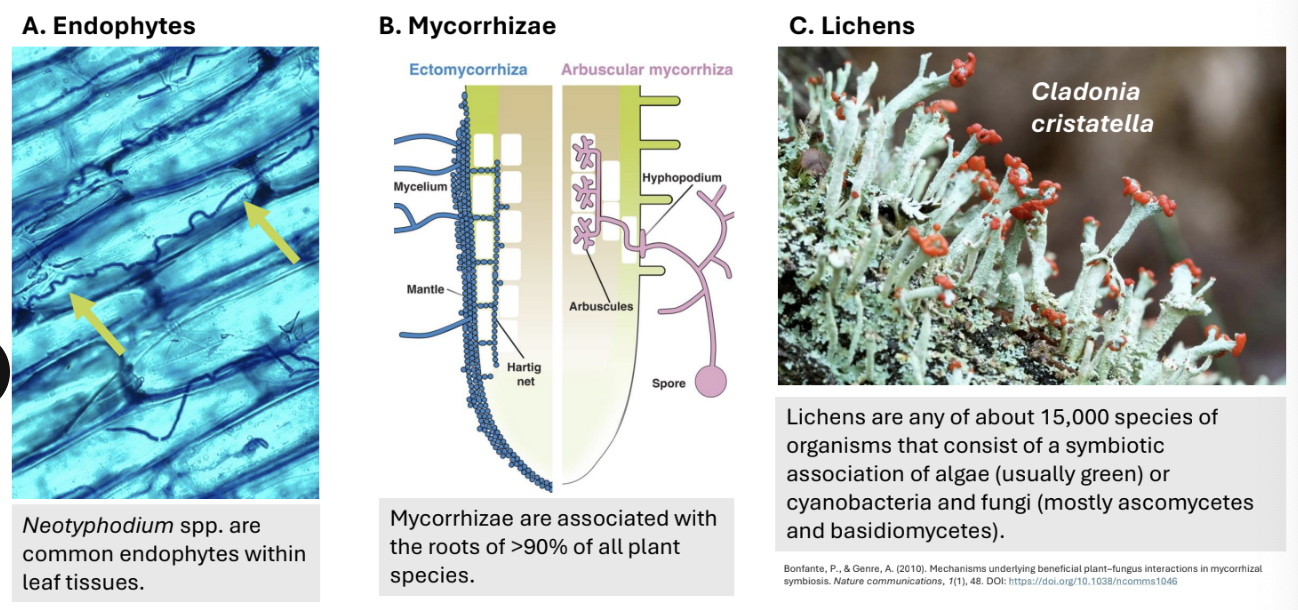
T/F: Both fungi and bacteria can fix nitrogen
FALSE
Fungi do not fix atmospheric nitrogen (N₂)

_ are any of about 15,000 species of organisms consisting of a symbiotic association between algae (usually green) or cyanobacteria and fungi (mostly ascomycetes and basidiomycetes)
Lichens
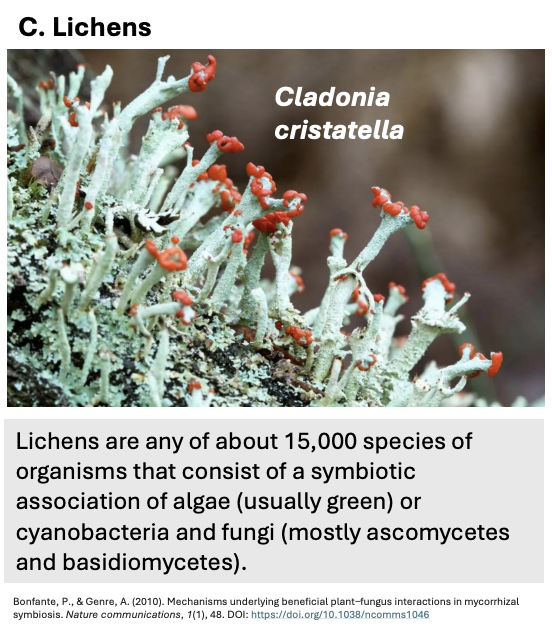
Explain the 3 primary ecological roles of aquatic fungi
Mycoloop = parasitic fungi rendering inedible phytoplanktons edible to zooplankton grazers either via fragmentation or by producing spores (that zooplankton can eat)
enables energy transfer UP the food chain to zooplankton then to fish
Mycoflux = any fungal interaction leading to the aggregation or disintegration of organic matter, thus affecting aquatic carbon matter (DissolvedOM, ParticulateOM)
affects carbon state of water (from particulate to dissolved)
changes how carbon moves (fluxes) thru water column
Benthic shunt = fungal colonization of organic litter rendering it palatable to macrozoobenthos, which become food for higher trophic levels, such as fish, thus increasing trophic transfer efficiency of the aquatic food web
*autochthonous OM = originates w/in ecosystem; allochthonous = from outside the ecosystem
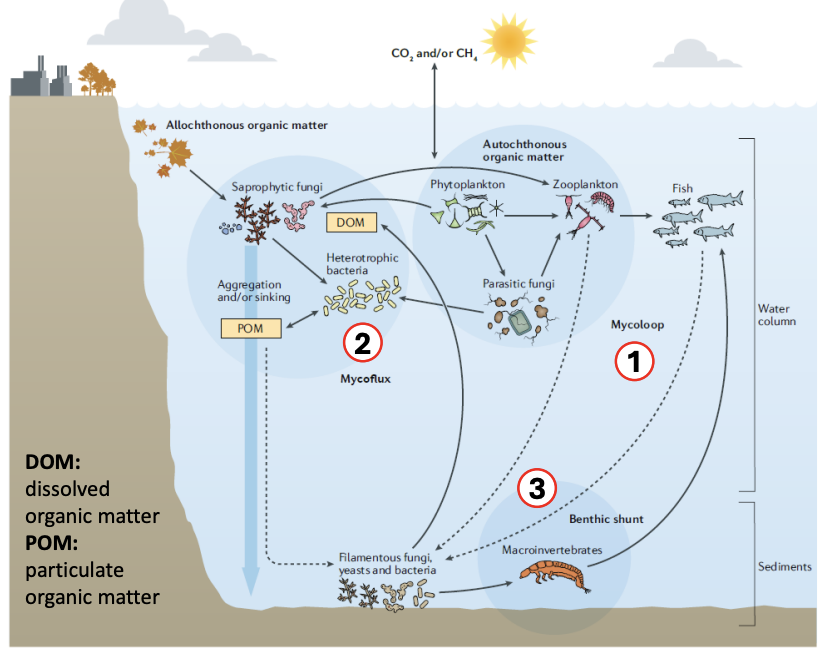
T/F: In aquatic mycoflux, DOM will remain suspended in water column, while POM aggregates or sinks to bottom of aquatic environment (sediment = benthic)
TRUE
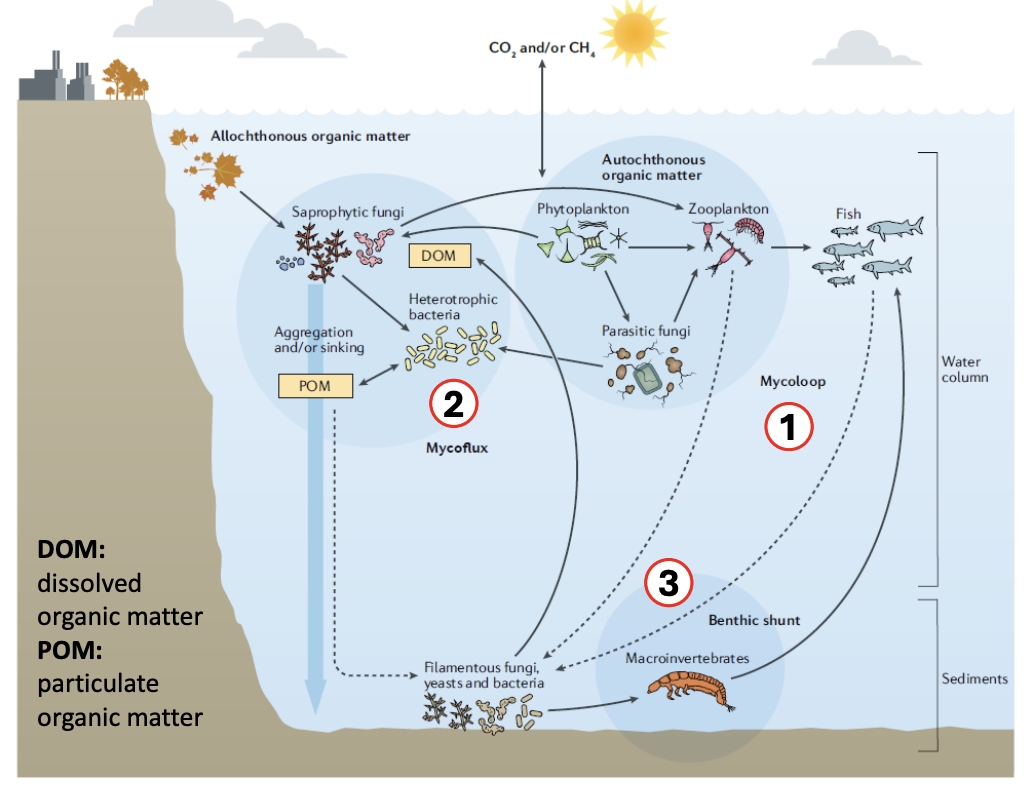
T/F: Mycoflux only increases carbon availability by disintegrating organic matter into DOM
FALSE
Mycoflux also causes aggregation, which may sink and reduce availability

T/F: Benthic shunt results in decreased carbon retention in the sediment since fungi make litter float
FALSE
The benthic shunt retains carbon in sediments and simply makes it available to benthic feeders
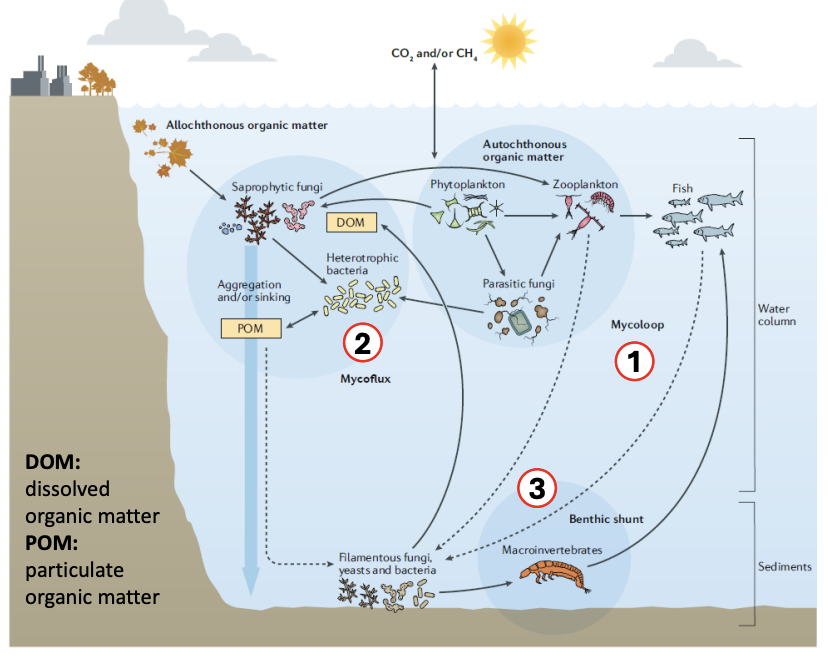
T/F: In the mycoflux, fungal activity can indirectly alter the sinking rate of organic particles
TRUE
By aggregating or breaking down POM, fungi influence whether particles sink or stay suspended
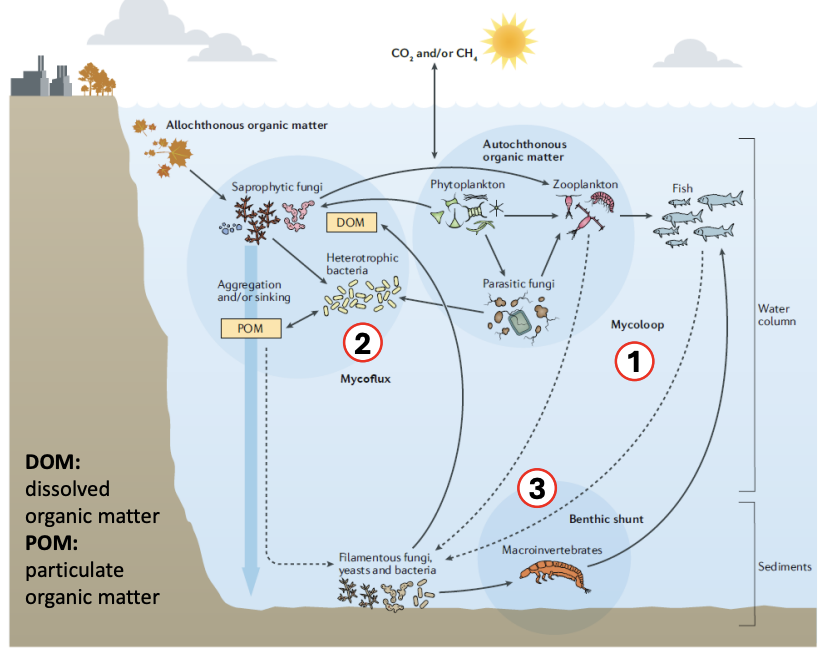
T/F: Mycoflux interactions can paradoxically lead to both carbon retention in sediments and increased availability in the water column
TRUE
Aggregation = sinking POM (retention in sediments);
Disintegration = DOM, stays suspended in water column

T/F: DOM is a form of carbon more likely to be affected by fungal disintegration, whereas POM is influenced by aggregation
TRUE
Fungal disintegration often produces DOM; aggregation deals with POM
Environmental interactions between fungi can fall under 1 of 3 categories, including _
(A) Exclusion = ability of 1 species to exclude another through indirect competition (exploitation competition) through various means, e.g., hogging resources/space
(B) Antagonism = ability of 1 species to exclude or replace another by directly affecting another organism through antibiotic production, parasitism, etc. (interference competition/combat)
(C) Coexistence = ability of 2 species to coexist (commensalism) to the benefit of 1 or both (mutualism)

T/F: Fungi-fungi interactions are difficult to observe in nature and study in situ, especially mutualism
TRUE
Usually, one must go into lab to replicate the same conditions
Mutualisms are rare bc a lot of fungus usually have the same needs, occupy same niche, and share the same resource
Exclusion vs. Antagonism
Exclusion = when 1 species excludes another via indirect or exploitation competition, e.g., hogging resources or space
Antagonism (interference competition/combat) = when 1 species excludes or replaces another by directly affecting another organism through ap antibiotic production, parasitism, etc.

_ happens when 1 species bars another from accessing a resource, e.g., take-all patch disease of fine turf grasses caused by monopoly of Gaeumannomyces graminis
Exploitation competition (exclusion)
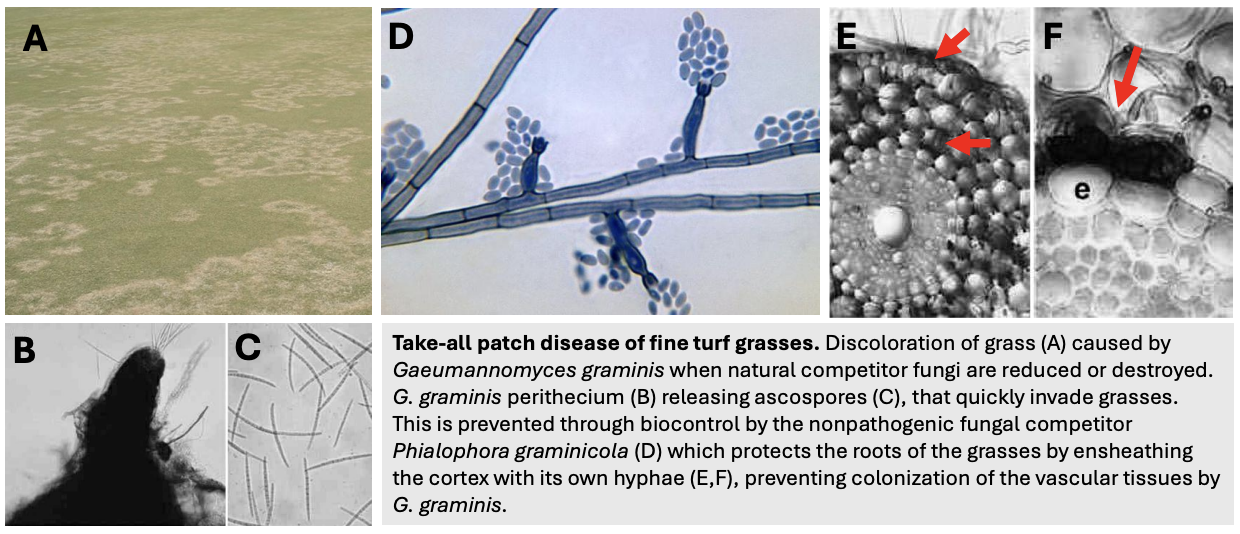
Explain 1 example of exploitation competition (exclusion) between fungi
Take-all patch disease of fine turf grasses
(A) Discoloration of grass caused by Gaeumannomyces graminis when natural fungal competitor is reduced or destroyed
(B) G. graminis perithecium (ascocarp) releasing ascopores, which quickly invade grasses
(C) This can be prevented through biocontrol by nonpathogenic fungal competitor Phialophora graminicola, which protects roots of grasses by (D) ensheathing the cortex (steele) with its own hyphae,
(E,F) thus preventing colonization of vascular tissues by G. graminis
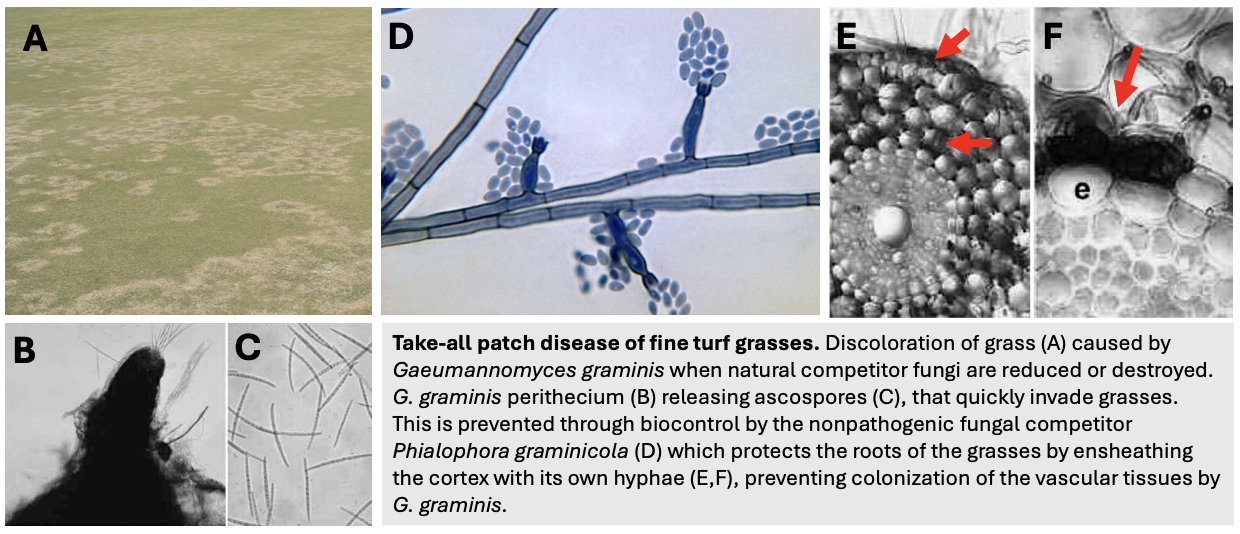
Give 3 ways through which fungi can become antagonistic to other fungi
ahm
Antibiotic production
Hyphal interference
Mycoparasitism
Biotrophic
Necrotrophic
_ species are a model of antibiotic production to antagonize other fungi because they produce _
Trichoderma
several volatile & nonvolatile compounds active against fungi, bacteria, or both including vtg6
Viridin
Trichodermin
Gliotoxin
6-PAP

Explain 1 example of antagonism thru antibiotic production between fungi
Trichoderma species are well-known for their ability to antagonize other fungi through antibiotic production
This is because they can produce several volatile & nonvolatile compounds, active against fungi, bacteria, or both, including vtg6
Viridin
Trichodermin
Gliotoxin
6-PAP
These antifungals are effective against fpancp
Fusarium proliferatum
Penicillium brevicopactum
Aspergillus flavus
Neofusicoccum batangarum
Colletotrichum gloeosporioides
Phytophthora parvispora
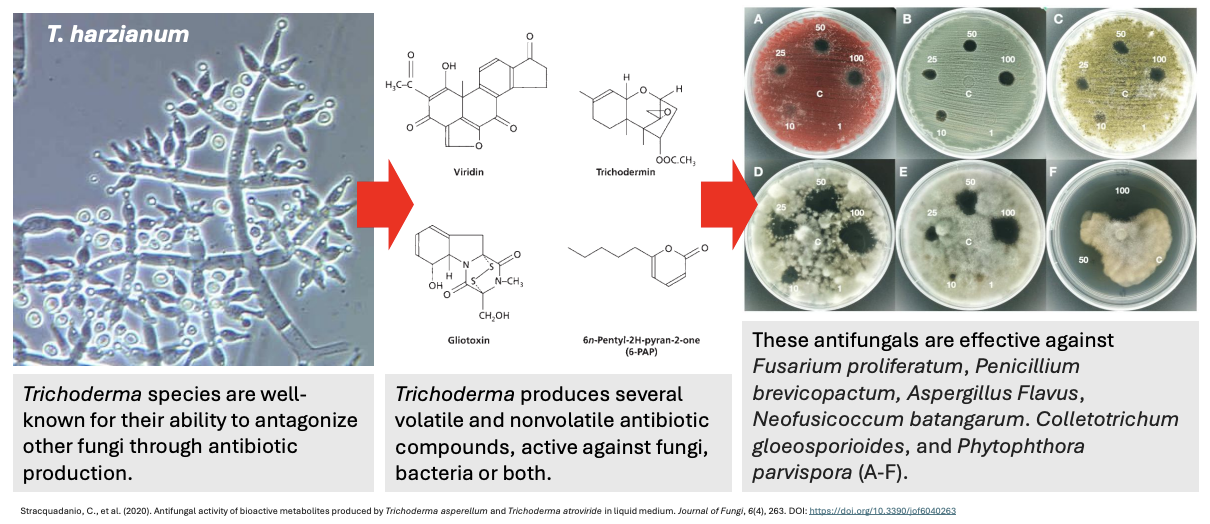
T/F: Trichoderma is a very common soil fungus
TRUE
You can find it by digging >5 cm of soil, especially in tropical environments

Antifungals vs. Mycotoxins
Antifungals = substances that kill or inhibit growth of fungi, often used in treating fungal infections in vertebrates
Has effect on fungus
Mycotoxins = toxic secondary metabolites produced by certain fungi, often under stress conditions
Effect of fungus on vertebrates
_ is an antagonistic fungal strategy for killing or inhibiting other fungi at points of contact
Hyphal interference (HI)
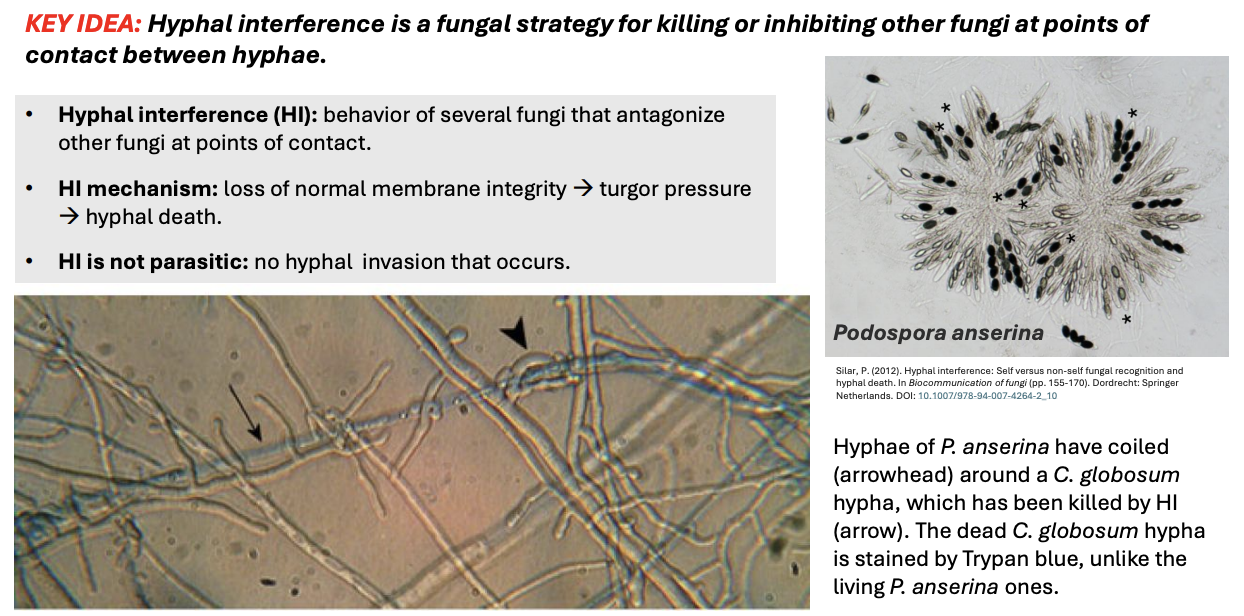
T/F: Hyphal interference is a form of fungal parasitism
FALSE
No hyphal invasion occurs in HI
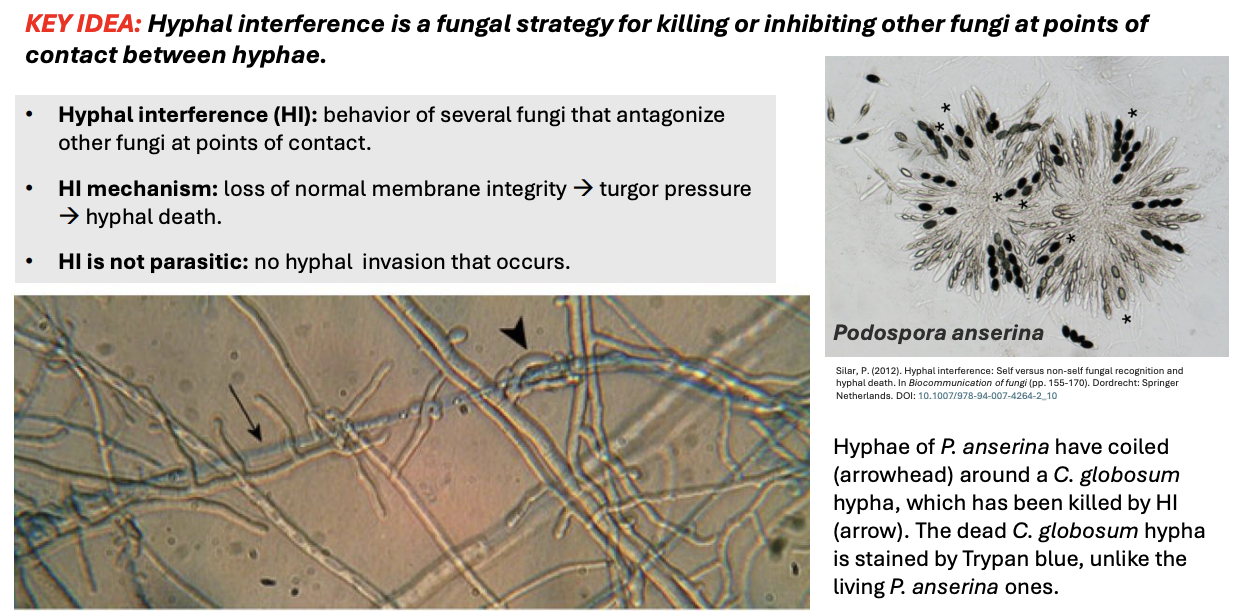
Explain mechanism of hyphal interference (HI)
Coiling of hypha of 1 species around another results in loss of normal membrane integrity → turgor pressure → hyphal death
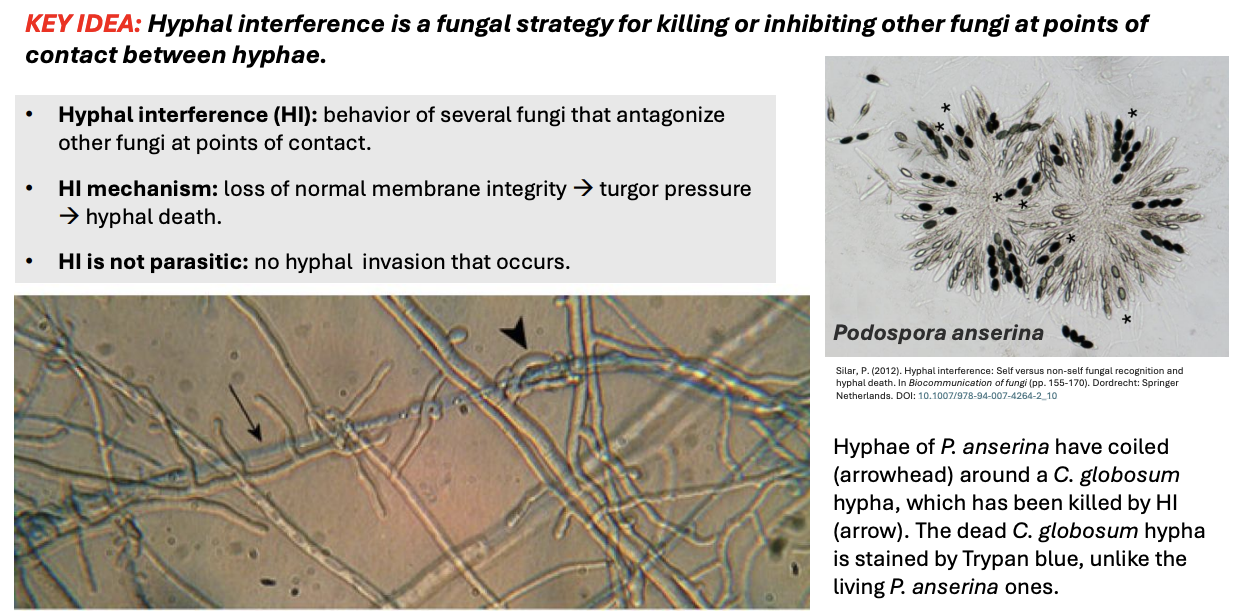
_ refers to the behavior of several fungi that antagonize other fungi at points of contact, e.g., Podospora anserina
Hyphal interference (HI)

Explain 1 example of antagonism thru hyphal interference between fungi
Hypha of Podospora anserina have coiled around C. globosum hypha, which has been killed via HI bc coiling around hypha leads to loss of normal membrane integrity > turgor pressure > hyphal death
Dead C. globosum hypha is stained Trypan blue, unlike living P. anserina ones
*HI not parasitic = no hyphal invasion occurs
HI = behavior of several fungi to antagonize others at points of contact

Explain autolytic activity of Podospora
Podospora has autolytic ability and can perform hyphal interference on itself, observed as ascocarp containing only 2 ascospores instead of 4, to control the number of viable spores that it produces as a response to changing environmental conditions

T/F: Fungi that do hyphal inteference usually attack only at 1 point
FALSE
They attack at multiple points

_ refers to when a fungus lives on or inside another fungus and feeds on it, often harming it but not necessarily killing the host in the process
Mycoparasitism

The fungi that parasitize other fungi can be grouped into 2 broad categories: _
Biotrophic mycoparasites establish a specialized feeding relationship, usually by producing a haustorium to penetrate and absorb nutrients from living fungal hyphae
Necrotrophic mycoparasites invade and destroy a wide range of fungal cell hosts using inhibitory toxins or metabolites then feed on dead cell contents
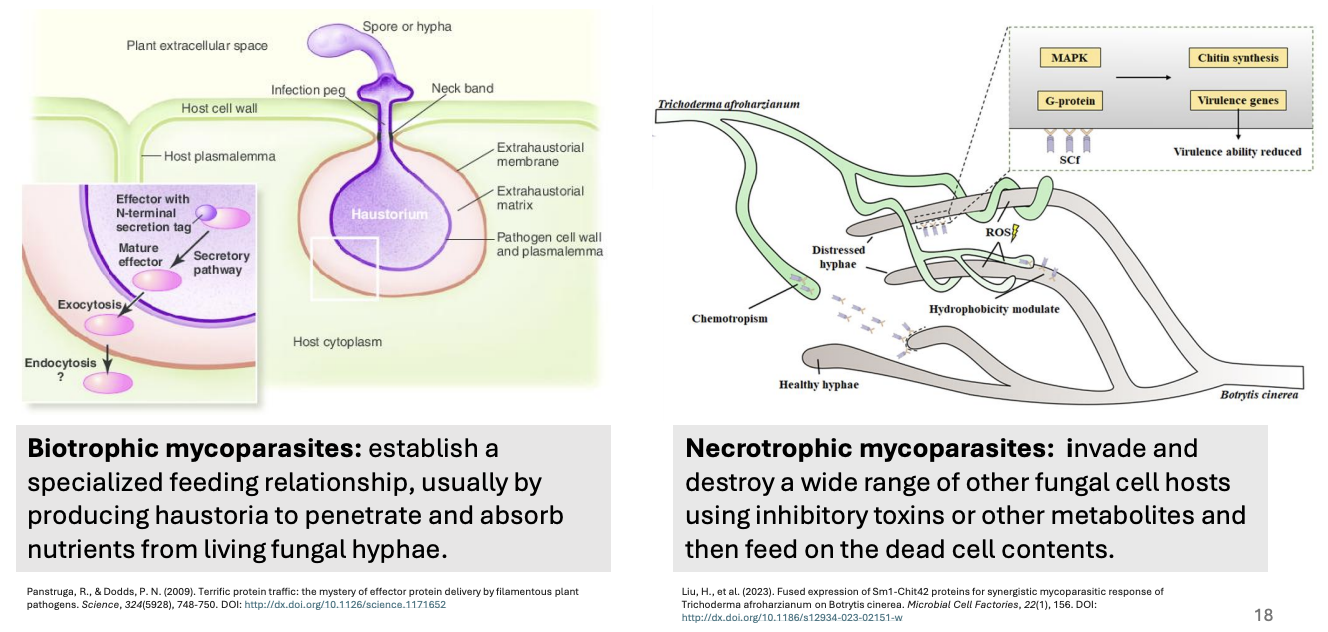
_ refers to the group of mycoparasites that establish a specialized feeding relationship, usually by producing a haustorium to penetrate and absorb nutrients from living fungal hyphae
Biotrophic mycoparasites
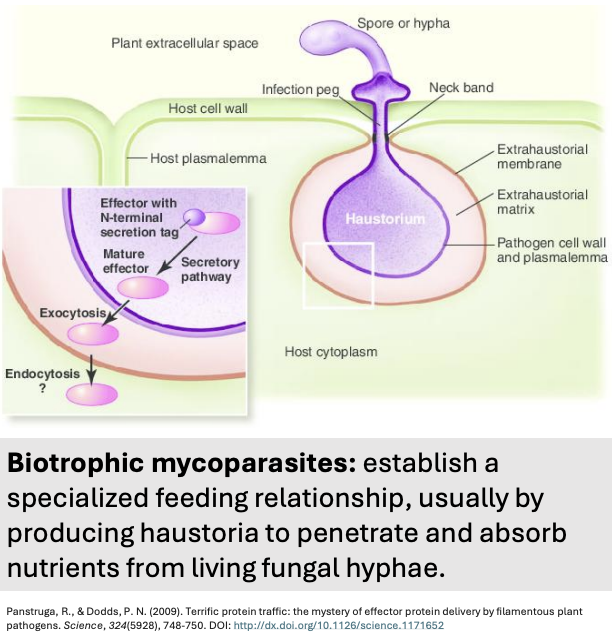
_ is the most common mechanism of infection
Haustorium production
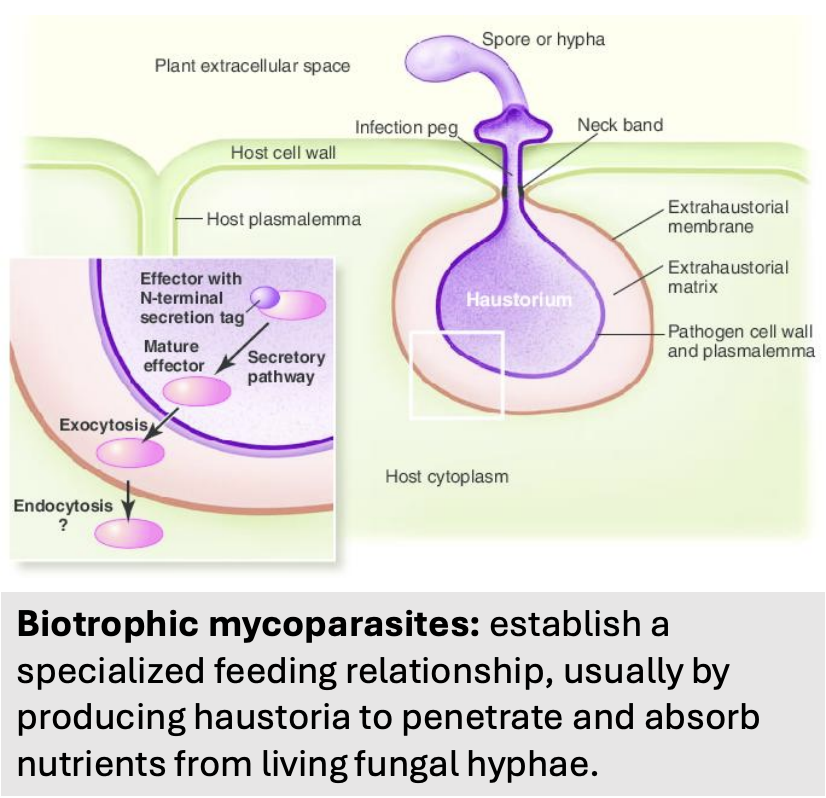
Explain mechanism of biotrophic mycoparasitism
Most common mechanism of infection = haustorium production
Spore or hypha of mycoparasite forms an infection peg that penetrates host cell wall
It forms a haustorium inside host cell but outside host cell membrane; surrounded by extrahaustorial membrane + matrix > host cytoplasm
Neck band seals haustorium to allow tight control of nutrient flow
Eventually, effector molecules are secreted by mycoparasite to manipulate fungal host cell
These are delivered via secretory pathway and released via exocytosis into host interface (extrahaustorial matrix)
Then possibly taken in by host cell via endocytosis (?)
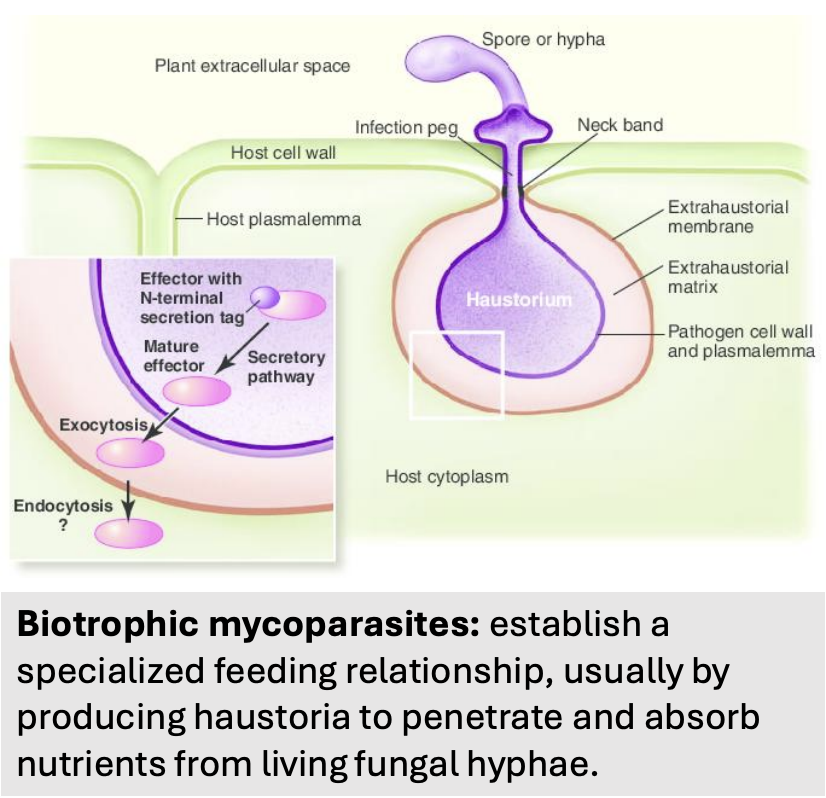
Explain mechanism of necrotrophic mycoparasitism
Trichoderma detects chemical signals from host & grows toward it
It attaches to host hyphae then releases ROS + inhibitory compounds > distressed host hyphae
Can also modulate hydrophobicity to improve adhesion & penetration
SCf (protein complex) may interact with host signaling pathways, including MAPK + G protein that control chitin synthesis & virulence genes, allowing parasite to reduce host virulence and thus increase Botrytis vulnerability
Once growing branch is cut off, they feed on dead parts
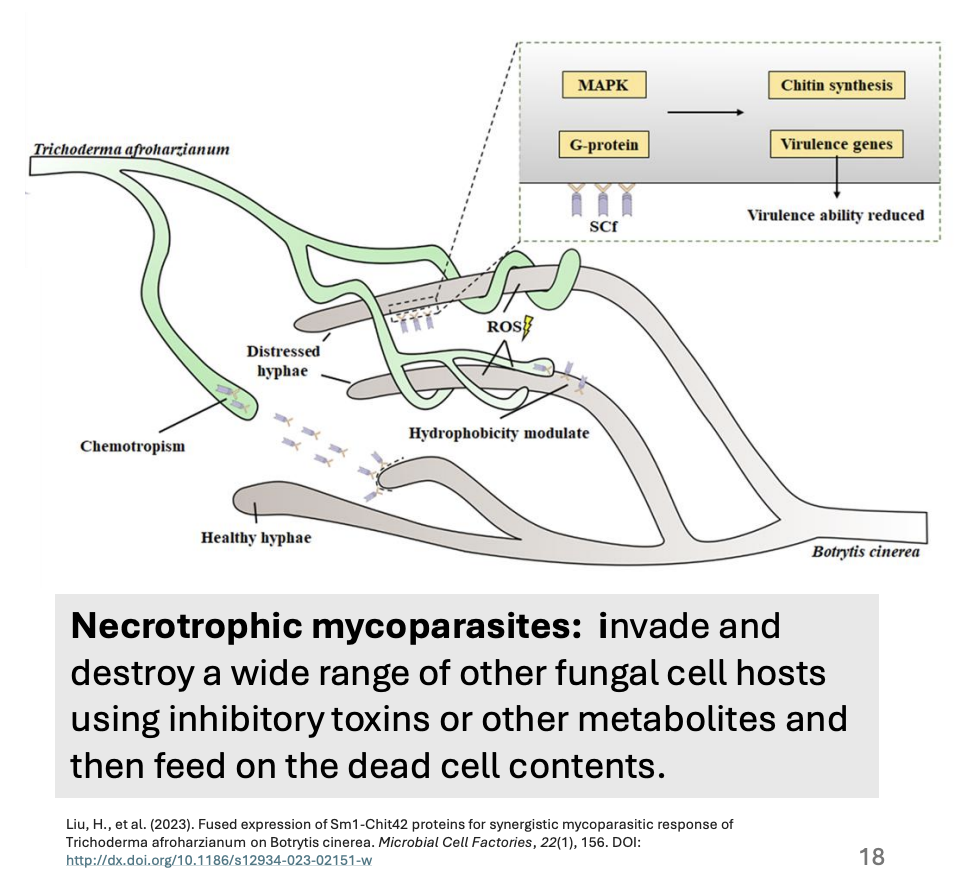
T/F: Necrotrophic mycoparasitism has more pronounced immediate effects than biotrophic mycoparasitism
TRUE
Bc biotrophic mycoparasites will try to keep their hosts well & alive
T/F: Both biotrophic and necrotrophic mycoparasites are host-specific
TRUE
_ refers to the group of mycoparasites that invade and destroy wide range of fungal cell hosts using inhibitory toxins or metabolites and then feed on dead cell contents
Necrotrophic mycoparasites

Explain 2 examples of biotrophic mycoparasitism (fungi-fungi)
Biotrophic mycoparasites seldom kill their fungal hosts because they need to feed on living tissues
(A) Piptocephalis unispora penetrating its fungal host C. recurvatus using an appressorium with a haustorium
Extrahaustorial membrane = where nutrient exchange happens
(B) Mycoparasitism of Rhizoctonia solani by Verticillium bigattum showing spirally germinating spores continuing to attack living hyphae along multiple points
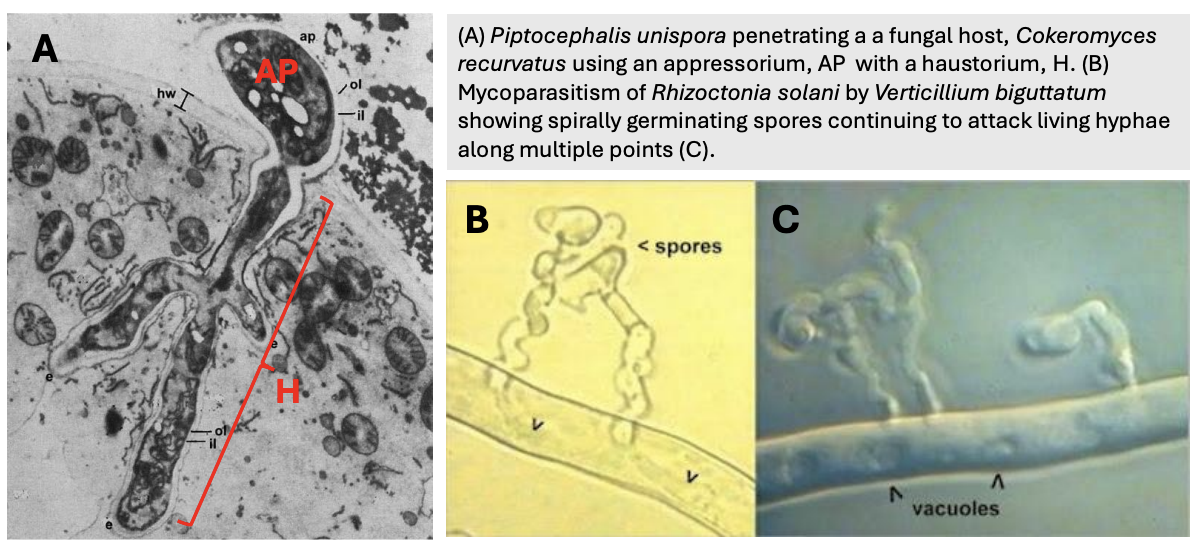
T/F: In biotrophic parasitism, the extrahaustorial membrane originates from the pathogen to protect the haustorium from the host's immune system
FALSE
The extrahaustorial membrane is host-derived, not pathogen-derived. It’s a modified host plasma membrane that surrounds the haustorium, maintaining separation while allowing nutrient exchange.
T/F: Both biotrophic and necrotrophic mycoparasites manipulate host gene expression using effector proteins
TRUE
Both use effectors, but for different goals:
Biotrophs use effectors to suppress immunity and maintain host viability.
Necrotrophs may use effectors or toxins to induce cell death or weaken defenses.
T/F: Necrotrophs can benefit from delayed host cell death to maximize nutrient yield before consumption
TRUE
While necrotrophs do kill, some may delay or modulate host death strategically to optimize breakdown and access to nutrients. Timing is everything in fungal warfare. So it's mostly true, depending on the species.
T/F: Biotrophic mycoparasites tend to kill their fungal cell hosts
FALSE
Biotrophic mycoparasites seldom kill their hosts because they need to feed on living tissues
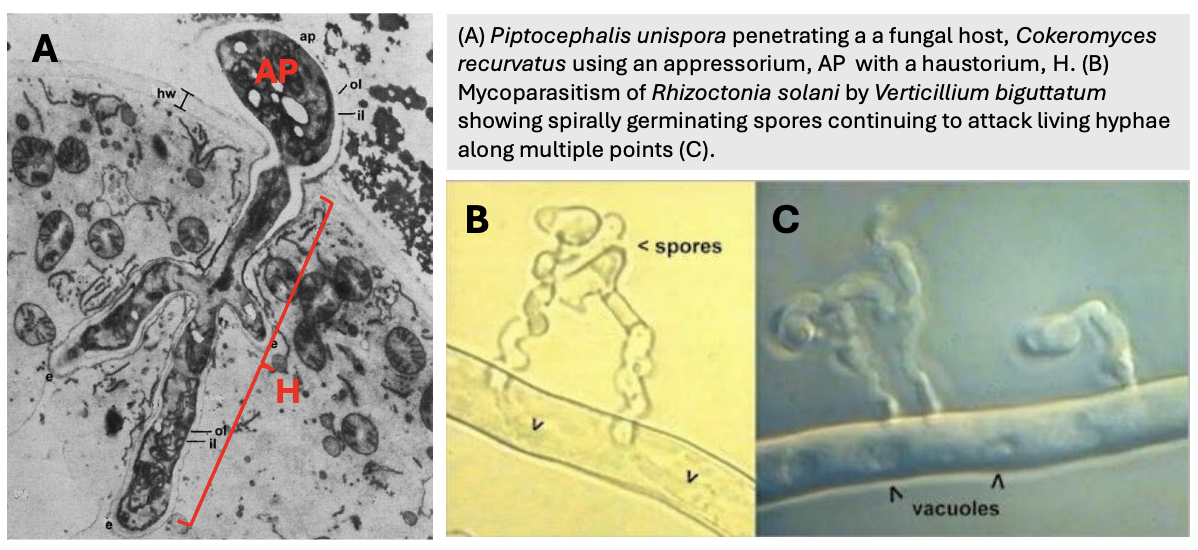
T/F: Necrotrophic mycoparasites kill their fungal hosts and feed on dead tissues and exudates
TRUE
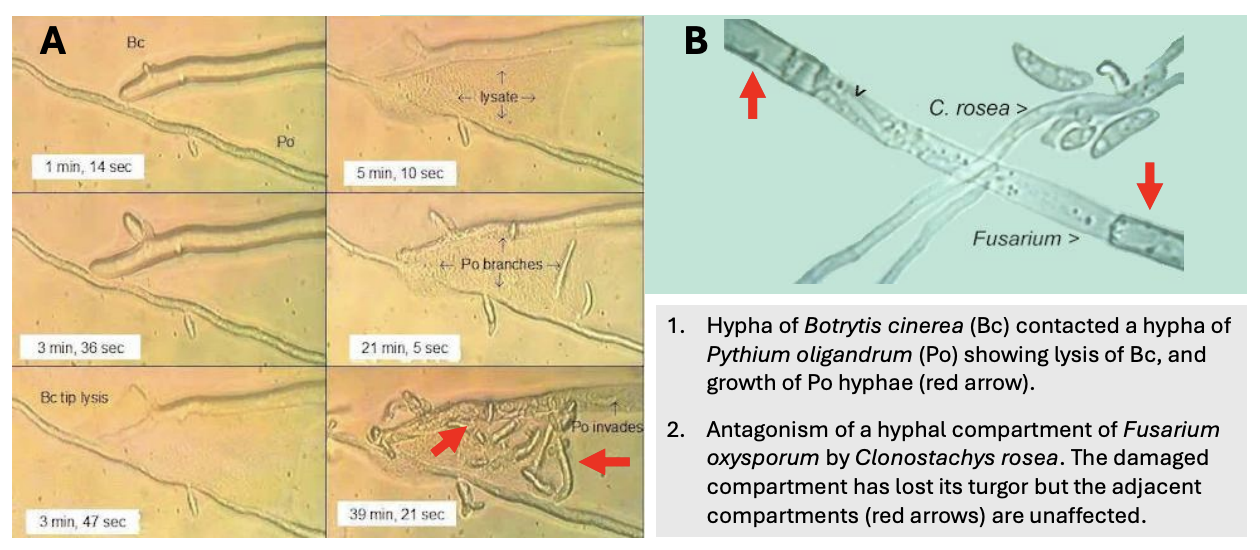
Give 2 examples of necrotrophic mycoparasitism (fungi-fungi)
Necrotrophic mycoparasites kill their fungal hosts and feed on the dead tissues and exudates
(A) Hypha of Botrytis cinerea contacting hypha of Pythium oligandrum, causing lysis of B. cinerea & subsequent invasion + hyphal branching (growth) of P. oligandrum
(B) Antagonism of hyphal compartment of Fusarium oxysporum by Clonostachys rosea
The damaged compartment lost its turgor, while the adjacent compartments were unaffected
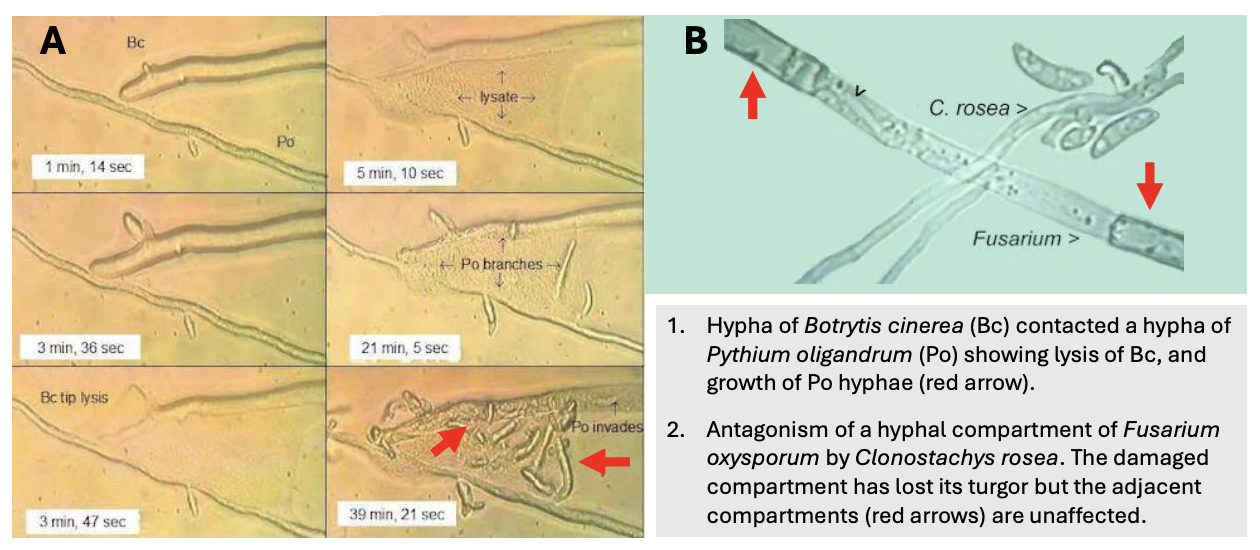
Apart from lichens, _ are uncommon between fungi
mutualism and commensalism
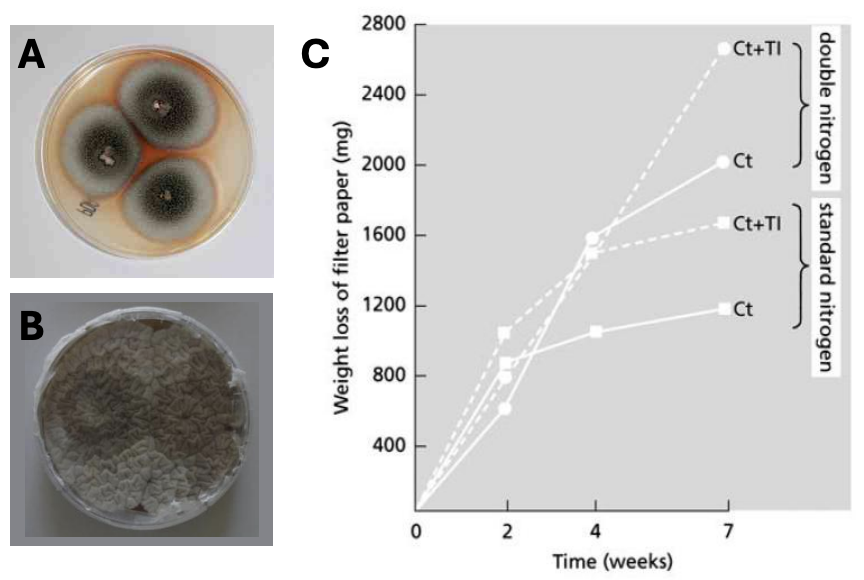
_ is when both organisms benefit from their association with each other
Mutualism
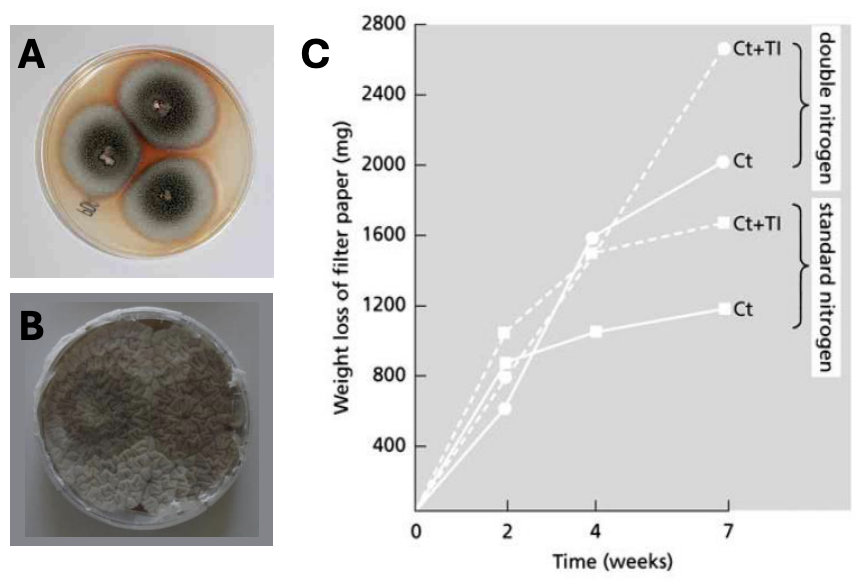
_ is when 1 organism benefits; the other is neither harmed nor benefitted
Commensalism
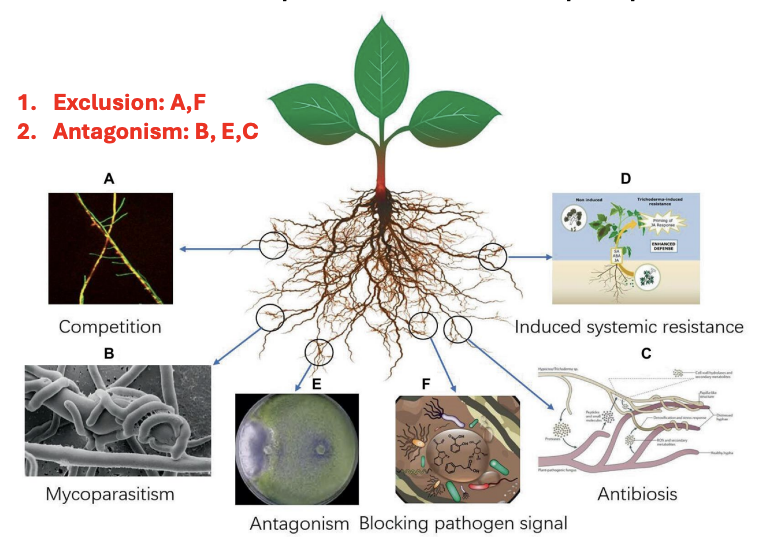
T/F: The relationship between Chaetomium thermophile and Thermomyces lanuginosus can be considered syntrophic
TRUE
Tl can only survive in cellulosic compost substrates w/ nitrate by using Ct degradation products, while Ct metabolism is improved when grown with Tl

Give 1 example of mutualistic interaction between fungi
Thermomyces lanuginosus (Tl) = non-cellulosic compost fungus nccf
Chaetomium thermophile (Ct) = cellulose-degrading compost fungus
When Tl & Ct are grown separately on filter paper + nitrate,
Ct can grow bc it is cellulose-degrading, nitrate-metabolizing
Tl can’t bc it’s non-cellulosic, non-nitrate-metabolizing
However, when Tl + Ct were grown together on filter paper + nitrate,
Ct provides degradation products that Tl can then use as C & N sources
*Growth of fungi in compost heaps (waste organic matter) = where fungal mutualism is usually observed
Between full mutualism - commensalism
Ammensalism = 1 harmed; 1 unaffected

_ species have been used as plant-protective biocontrol agents
Trichoderma
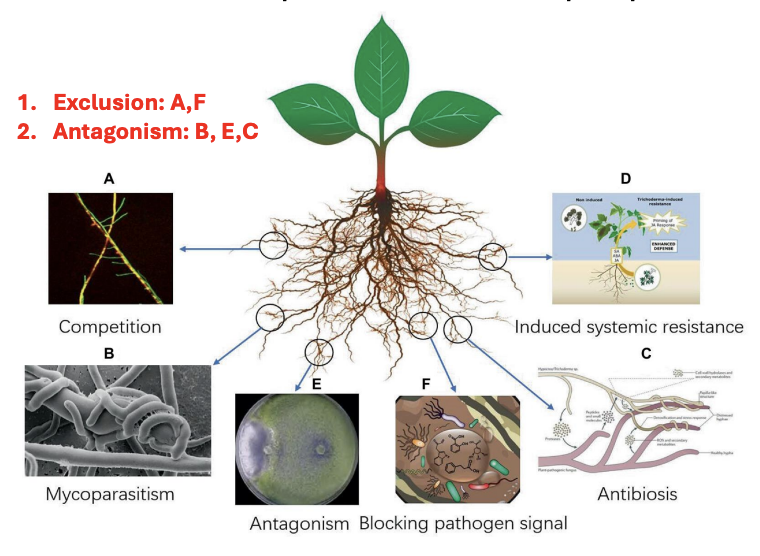
Trichoderma species have been used as plant-protective biocontrol agents, as these are capable of: _(6)
These are mainly used to _
Spray soil w/ Trichoderma
Exclusion = af ; antagonism = bec
cmai ab
Competition (exclusion)
Mycoparasitism (antagonism)
Antibiosis (antagonism)
Induced systemic resistance
Antagonism (antagonism)
Blocking a pathogen signal (exclusion)
Mainly used to cpe
Control soil-borne diseases and some leaf & panicle diseases of various plants
Promote plant growth, increase nutrient utilization efficiency, enhance plant resilience
Establish a safe, low-cost, effective, eco-friendly slee biocontrol agents for different crop species

How does a fungus (e.g., Trichoderma) induce higher systemic resistance in plants?
Trichoderma can boost plant immunity by colonizing the roots and sending signals that “prime” the plant’s defense system, as these can activate hormone pathways, e.g., jasmonic acid, so that plants would respond faster & stronger when real pathogens attack

Explain Trichoderma species as biocontrol agents
Trichoderma species have been used as plant-protective biocontrol agents
Bc they’re capable of cmai ab
Competition (exclusion)
Mycoparasitism (antagonism)
Antibiosis (antagonism)
Induced systemic resistance
Antagonism
Blocking a pathogen signal (exclusion)
And thus mainly used to cpe
Control soil-borne diseases and some leaf & panicle disease of various plants
Promote plant growth, increase nutrient utilization efficiency, & enhance plant resilience
Establish safe, low-cost, effective, eco-friendly biocontrol agents for different crop species
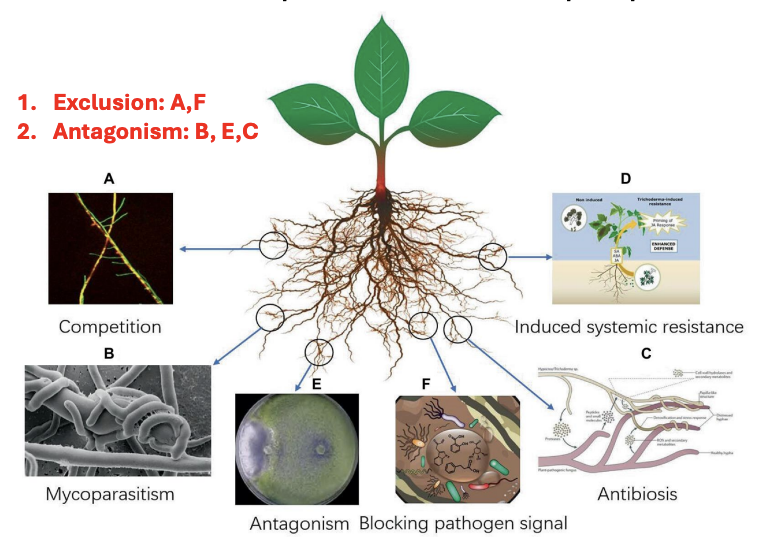
_ has been tested as biocontrol agents for conifer pathogens
Podospora hyphal interference (HI)
The formation of a barrage zone in an experimental setup is indicative of _ often due to _
Antagonism (non-fusion)
Chemical or physical defense between fungi

Explain Podospora as biocontrol agents against conifer pathogens
Heterobasidion annosum infection on 5yo (A) & 12yo (B) Scots pine trees (rotting of roots + stems),
showing (C) cell wall degradation & (D) fungal hyphal penetration
When plants age, they produce sclerenchyma, which has lignin + suberin for conducting water
When fungus secretes enzymes, these cause de-lignification of sclerenchyma, and bc lignin is degraded, sclerenchyma can no longer hold water and thus plant dies
(E) Experimental setup showing (F) barrage zones between Podospora & Heterobasidion
Barrage zone = visible line/area of interaction where 2 fungal colonies meet but don’t grow into each other often due to antagonism
(G) total overgrowth of Podospora at 20 days after HI
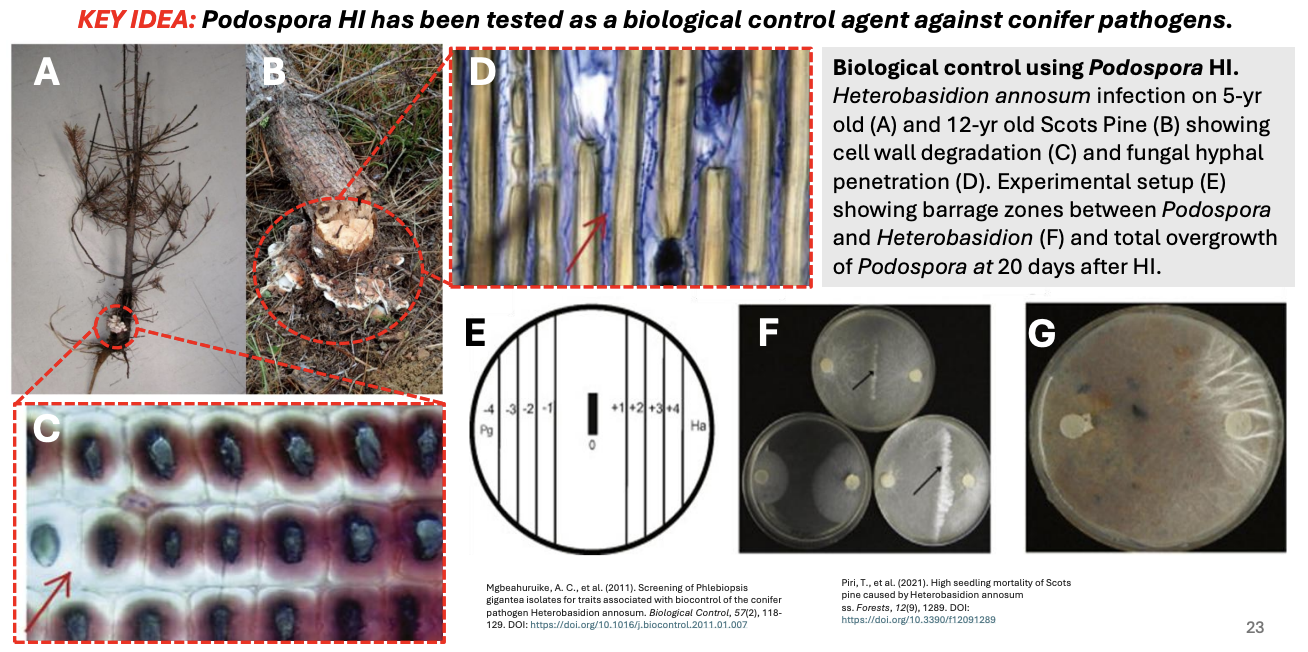
T/F: Podospora HI has been experimentally shown to penetrate Heterobasidion hyphae
TRUE
Based on the data, hyphal penetration was observed, which supports its role in direct antagonism
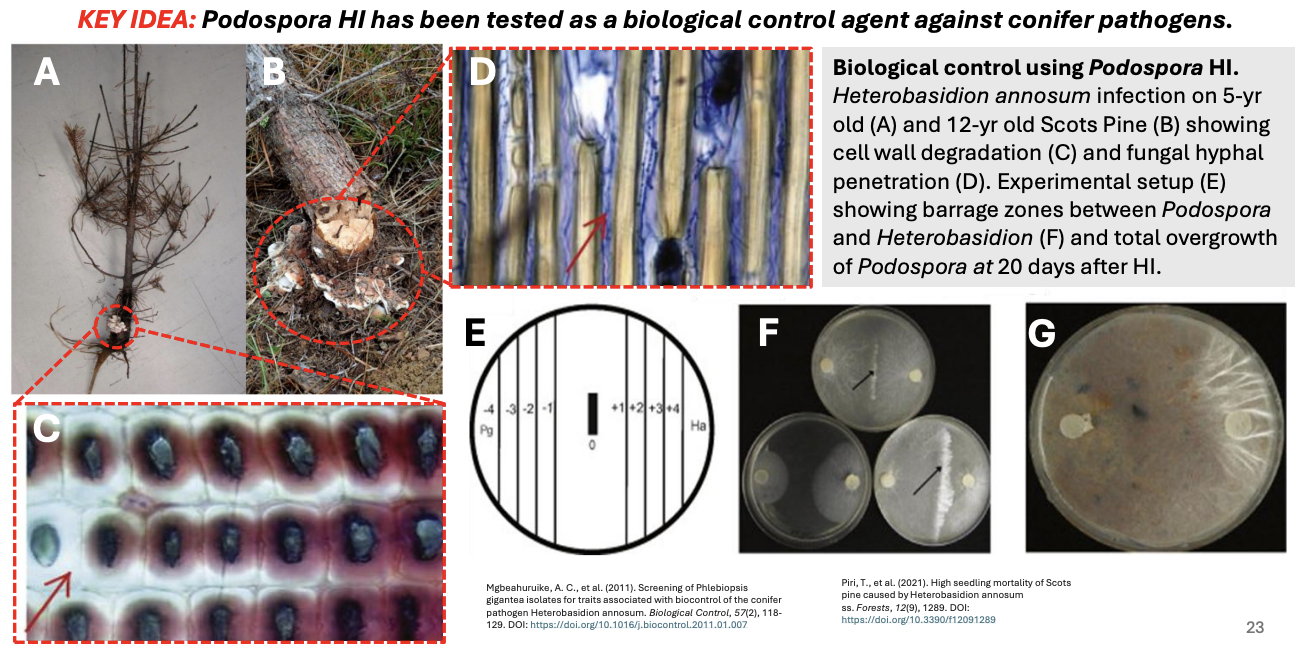
Why must one be cautious in testing out biocontrol agents in situ?
Bc you are introducing something not native to the environment and thus could have potential ecological effects, e.g., affect nutrient deposition, cause nutrient imbalance, etc.

_ refers to any of several prolonged living arrangements between members of 2 different species, including _
Symbiosis mcp
Mutualism
Commensalism
Parasitism
Fungi have several symbiotic associations with _
paa
Plants
Algae / cyanobacteria
Animals
_ is when fungi and their partners become so intimately dependent on one another that they have lost the ability to live alone
Obligate symbioses
Explain common types of symbiosis, fungus + their partners
mlger b&a sf
Mycorrhizae
F: Asco-, Basidio-, Glomero-
P: Land plants, e.g., Gymnosperms, Angiosperms, Bryophytes, Pteridophytes gabp
Lichens
Asco-, sometimes Basidio-
Green algae / cyanobacteria
Geosiphon pyriforme
Glomerales-like fungus
Nostoc (cyanobacterium)
Fungal endophytes of grasses
Neotyphodium, Clavicipitaceous fungi
Several grasses of family Poaceae
Rumen symbioses
Obligately anaerobic Chytridiomycota
Ruminant animals
Bark beetles & ambrosia fungi
Various Basidio-, Asco-, mitosporic fungi
Beetles
Siricid wood wasps
Amylostereum areolatum (Basidio)
Trees
Fungus gardens of leaf-cutting ants, termites, wood-boring beetles
Basidio (Termitomyces, Leugaricus)
Ants, termites, beetles
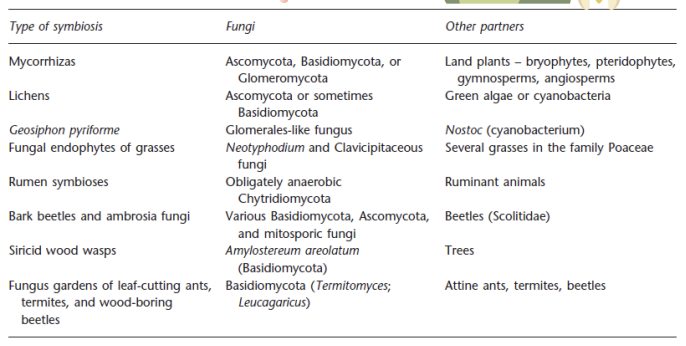
T/F: Fungi are involved in a wide range of intimate symbiotic associations with other organisms that shape many aspects of global ecology
TRUE
Explain 3 main types of symbioses
Symbiosis = any of several prolonged living arrangements between members of 2 diff species, including mutualism, commensalism, parasitism
Fungi have several symbiotic interactions with plants, algae/cyanobacteria, animals
Obligate symbiosis is when fungi & their partners become so intimately dependent on 1 another that they’ve lost ability to live alone
Types of symbiosis + fungi + other partners
mlger b&a sf
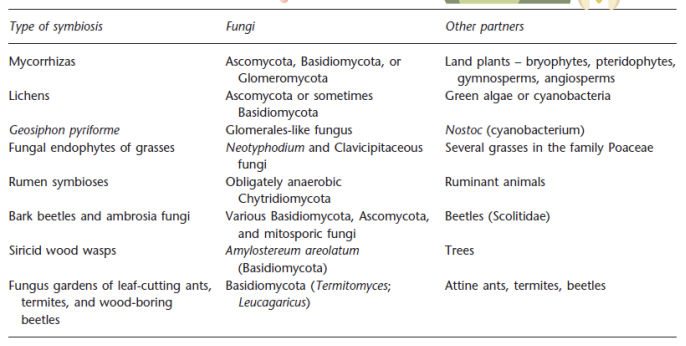
Enumerate examples of mutualistic interactions of fungi with other organisms
pemac elwa
Plant endophytes
Mycorrhizae (AMF, EMF)
Algae & Cyanobacteria as
Endophytes
Lichens
Animals symbioses
Wood wasps
Arthropods
_ live inside plants and may protect them against parasites (have anti-herbivory activity)
Endophytes
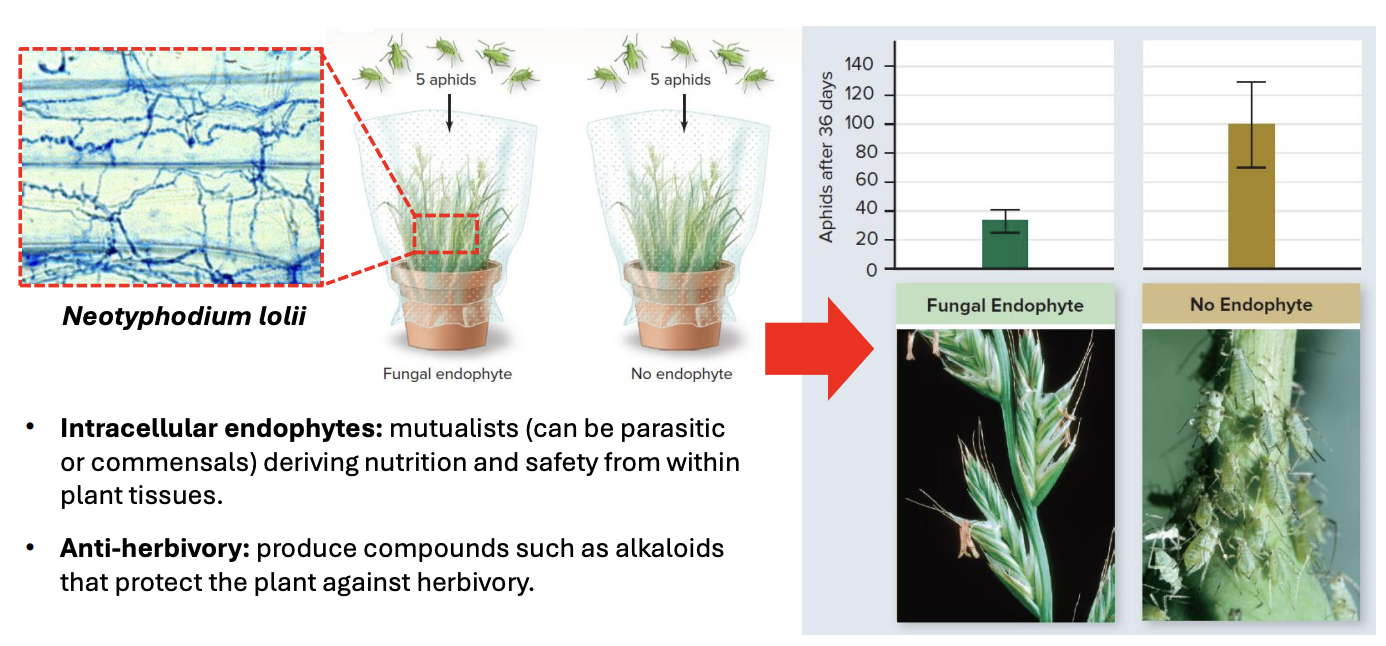
T/F: Fungal endophytes derive nutrients from their plant hosts but not to the extent that the plant is robbed off of majority of what it produces
TRUE
_ are mutualists (can be parasitic or commensal) deriving nutrition & safety from within plant tissues; in return, they have anti-herbivory activity, producing compounds such as alkaloids that protect plant against herbivory/parasites
Intracellular endophyte
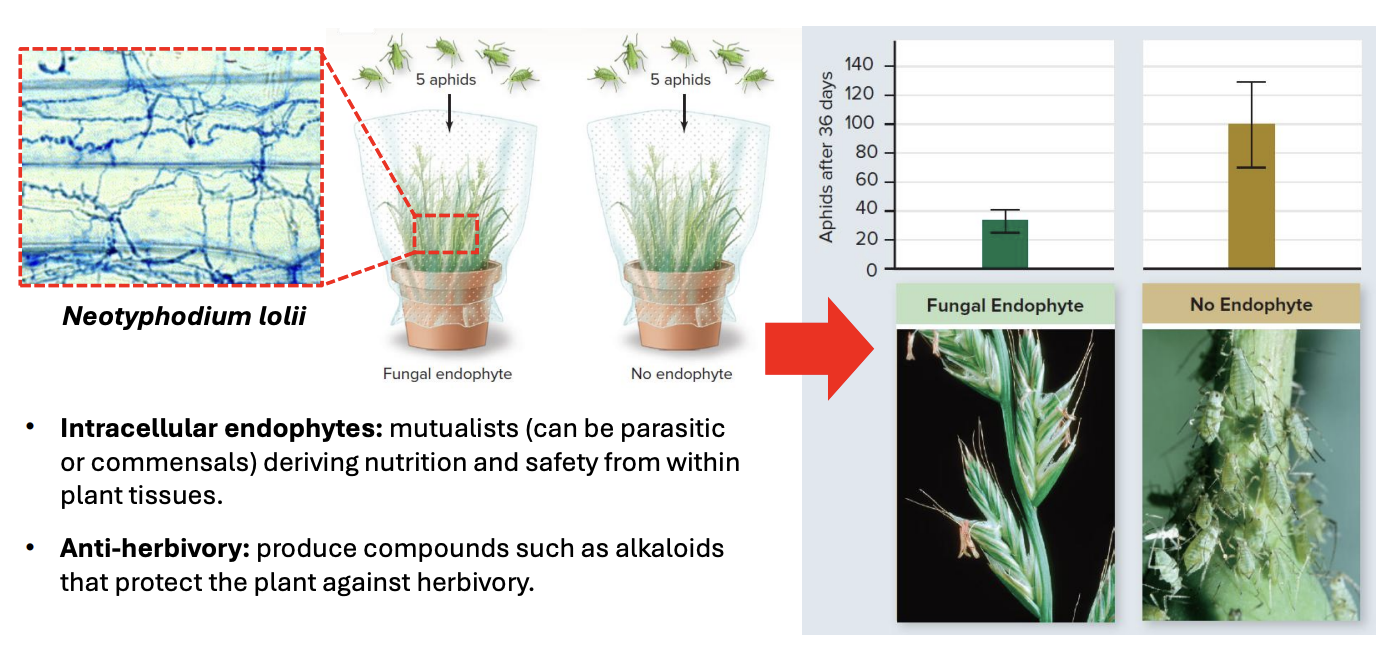
Explain fungi symbioses as plant endophytes
Endophytes = live inside plant & may protect them against parasites
Intracellular endophytes = mutualists (can be parasitic or commensal) deriving nutrition & safety from within plant tissues
In return, they have anti-herbivory activity, producing compounds, e.g., alkaloids, that protect plant against herbivory/parasites
In an experiment, they infested (1) a plant with fungal endophytes (Neotyphodium lolii) and (2) a plant with no fungal endophytes with an equal number of aphids
After several days, they observed that the plant with fungal endophytes had significantly less aphid infestation, supporting the anti-herbivory activity of fungal endophytes in plants
